Forums
- Forums
- Axis And Allies Forum
- General Discussion
- Aviation News
Aviation News
Post a reply
- Go to Next topic
- Go to Welcome
- Go to Introduce Yourself
- Go to General Discussion
- Go to Screenshots, Images and Videos
- Go to Off topic
- Go to Works in Progress
- Go to Skinning Tips / Tutorials
- Go to Skin Requests
- Go to IJAAF Library
- Go to Luftwaffe Library
- Go to RAF Library
- Go to USAAF / USN Library
- Go to Misc Library
- Go to The Ops Room
- Go to Made in Germany
- Go to Campaigns and Missions
- Go to Works in Progress
- Go to Juri's Air-Raid Shelter
- Go to Campaigns and Missions
- Go to Works in Progress
- Go to Skinpacks
- Go to External Projects Discussion
- Go to Books & Resources
-
 Main AdminMaj. Gen. Eldon ?Al? Joersz, USAF pilot retired, front, and Lt. Col. George ?GT? Morgan, USAF retired reconnaissance systems officer, sit inside the cockpit of the SR-71 aircraft they flew when setting the world absolute speed record for jet-powered aircraft on July 28, 1976. The two were at the Museum of Aviation in Warner Robins, Georgia for the 40th anniversary of the historic flight. (U.S. Air Force photo's by Tommie Horton/Released)
Main AdminMaj. Gen. Eldon ?Al? Joersz, USAF pilot retired, front, and Lt. Col. George ?GT? Morgan, USAF retired reconnaissance systems officer, sit inside the cockpit of the SR-71 aircraft they flew when setting the world absolute speed record for jet-powered aircraft on July 28, 1976. The two were at the Museum of Aviation in Warner Robins, Georgia for the 40th anniversary of the historic flight. (U.S. Air Force photo's by Tommie Horton/Released)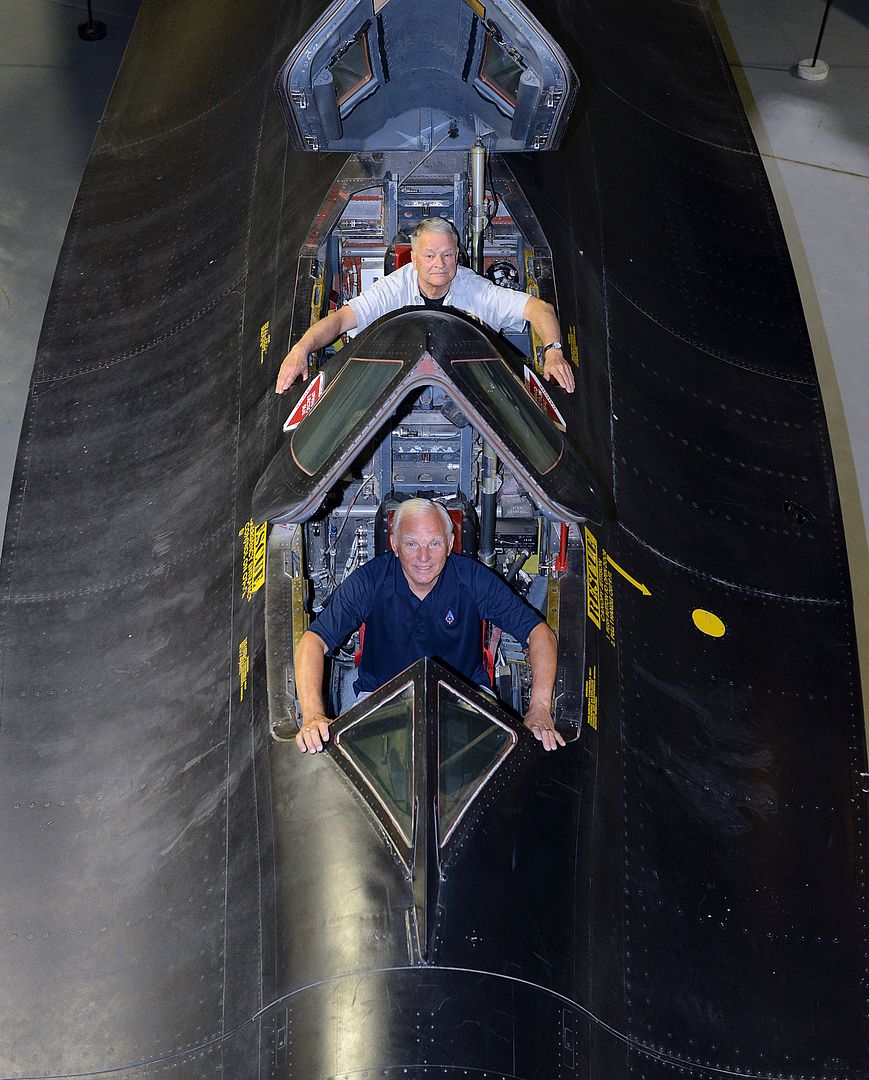
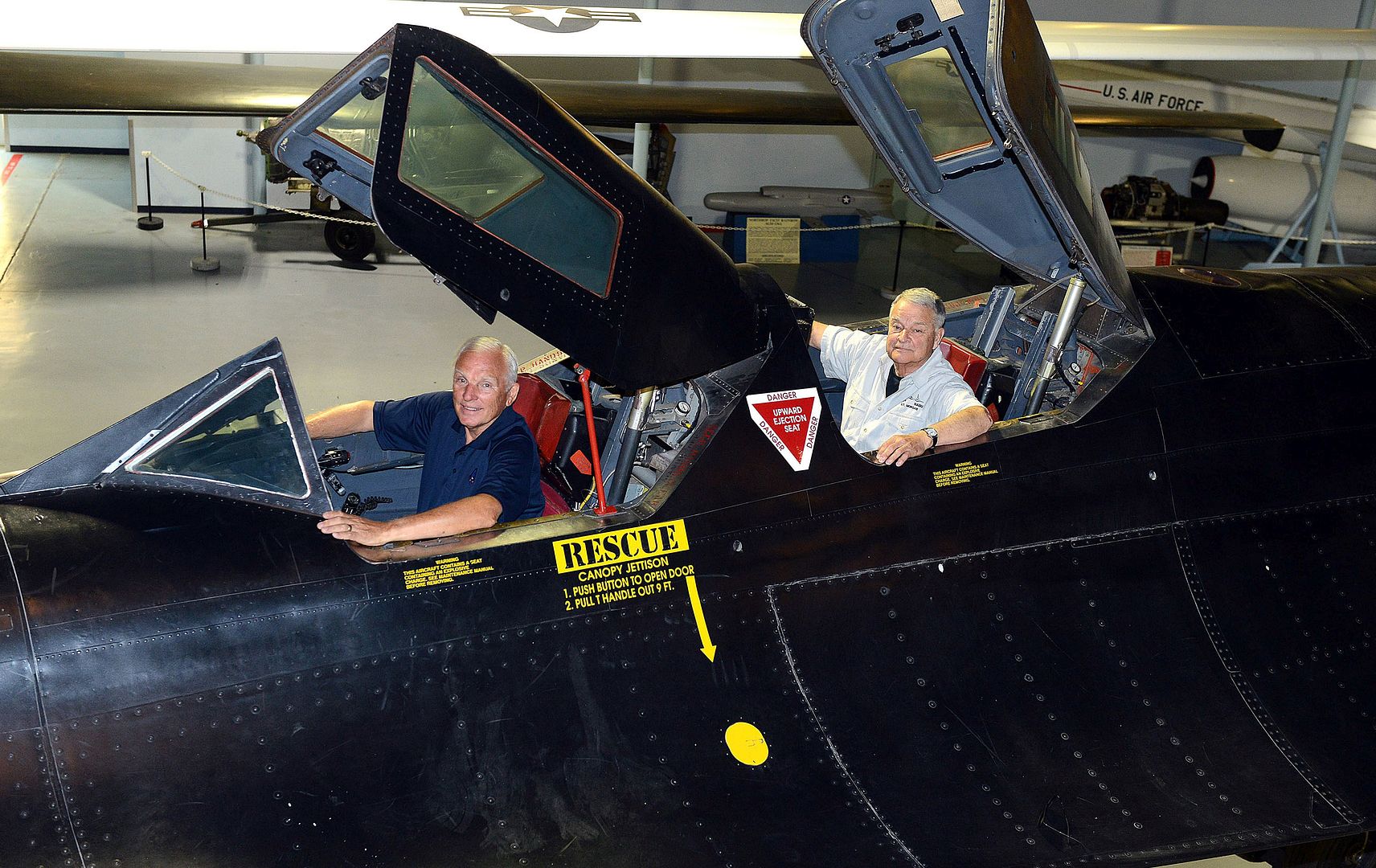
ARABIAN GULF (July 28, 2016) - An F/A-18C Hornet assigned to the Wildcats of Strike Fighter Squadron (VFA) 131 takes off from the aircraft carrier USS Dwight D. Eisenhower (CVN 69) (Ike). Ike and its Carrier Strike Group are deployed in support of Operation Inherent Resolve, maritime security operations and theater security cooperation efforts in the U.S. 5th Fleet area of operations. (U.S. Navy photo by Mass Communication Specialist 3rd Class J. Alexander Delgado/Released)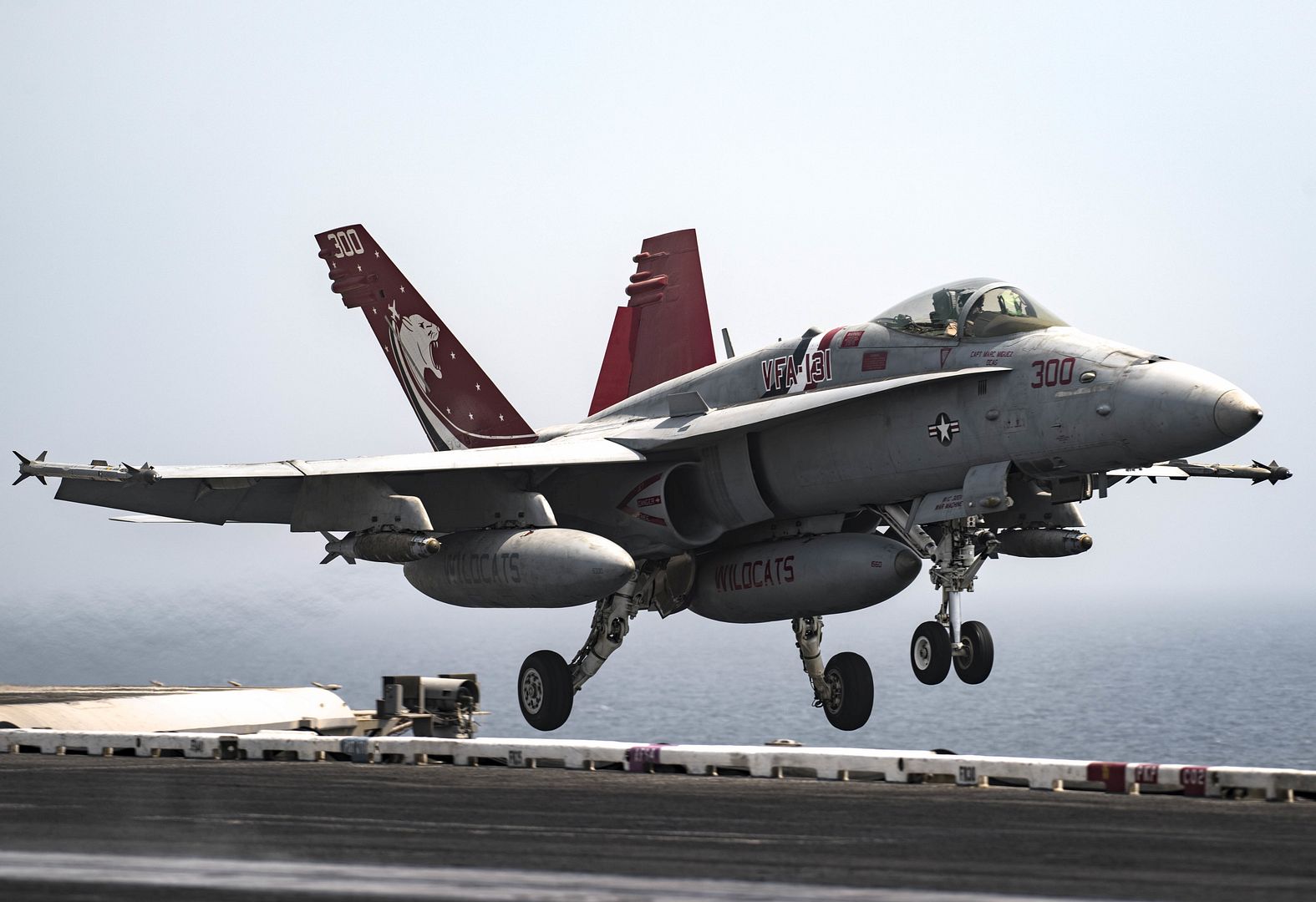
Andersen Air Force Base, Guam --
The U.S. Air Force?s B-1B Lancers are scheduled to deploy to Andersen Air Force Base, Guam, 6 Aug. 2016 for the first time since April 2006 in support of U.S. Pacific Command?s Continuous Bomber Presence mission.
The B-1?s will replace the B-52?s currently deployed from Minot AFB, N.D. While this is not the first basing of B-1s in the PACOM area of responsibility, it is the first time in 10 years.
With a large weapon capacity and exceptional standoff strike capability, the B-1 will provide U.S. Pacific Command and its regional allies and partners with a credible, strategic power projection platform.
This forward deployed presence demonstrates continuing U.S. commitment to stability and security in the Indo-Asia-Pacific region. The bombers will be accompanied by approximately 300 Airmen from Ellsworth AFB, South Dakota.
Air Force Global Strike Command continues to routinely deploy bombers to Andersen AFB, which provide opportunities for our Airmen to advance and strengthen regional alliances and our long-standing military-to-military partnerships throughout the Indo-Asia-Pacific.
The B-1 units bring a unique perspective and years of repeated combat and operational experience from the Central Command theater to the Pacific. They will provide a significant rapid global strike capability that enables our readiness and commitment to deterrence, offers assurance to our allies, and strengthens regional security and stability in the Indo-Asia-Pacific region.
Most importantly, these bomber rotations provide Pacific Air Forces and U.S. Pacific Command commanders a global strike and extended deterrence capability against any potential adversary.
Today is "Tiger day".
An animal dear to the heart of aviators
Photo's courtesy of the Armee de l'air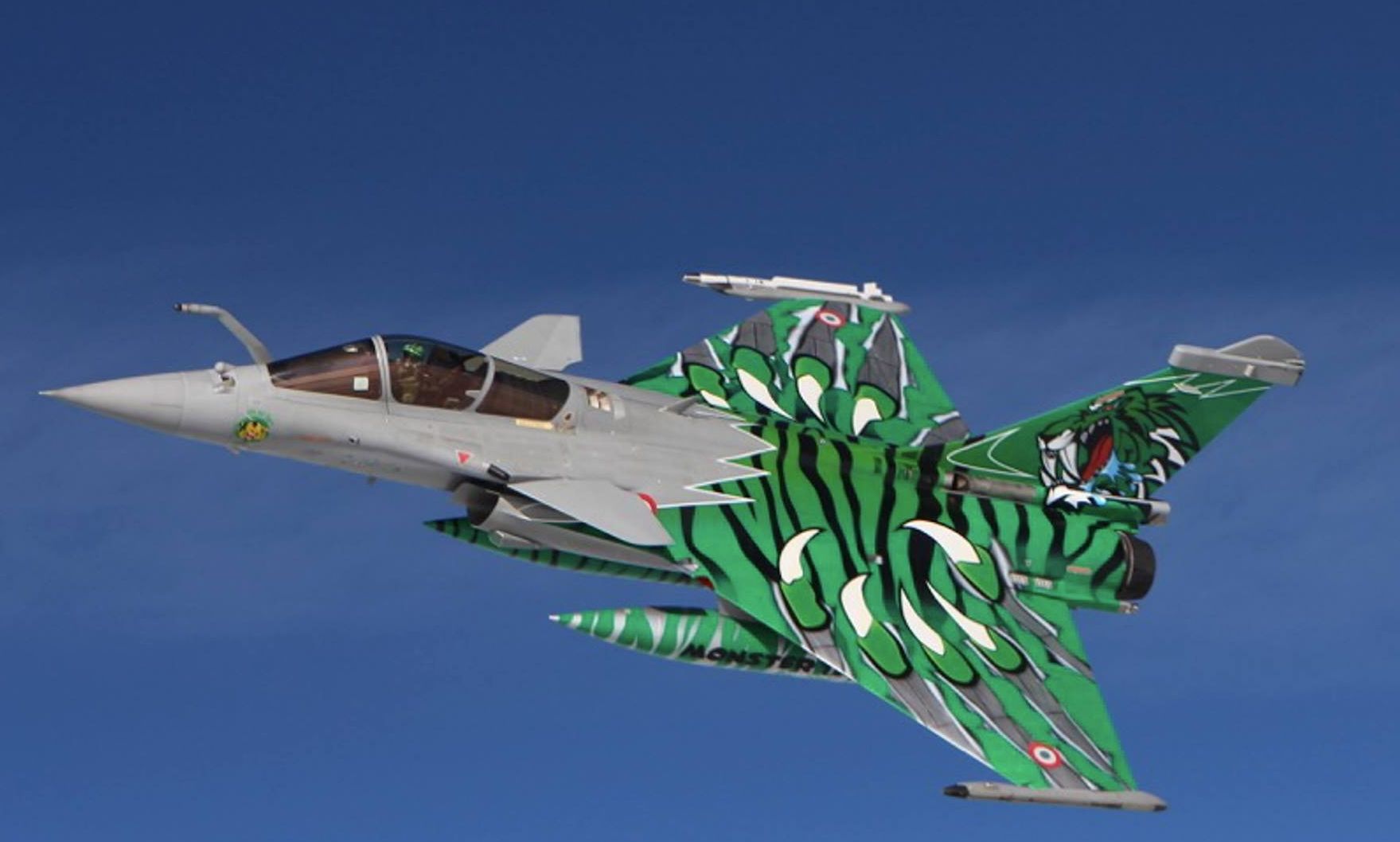
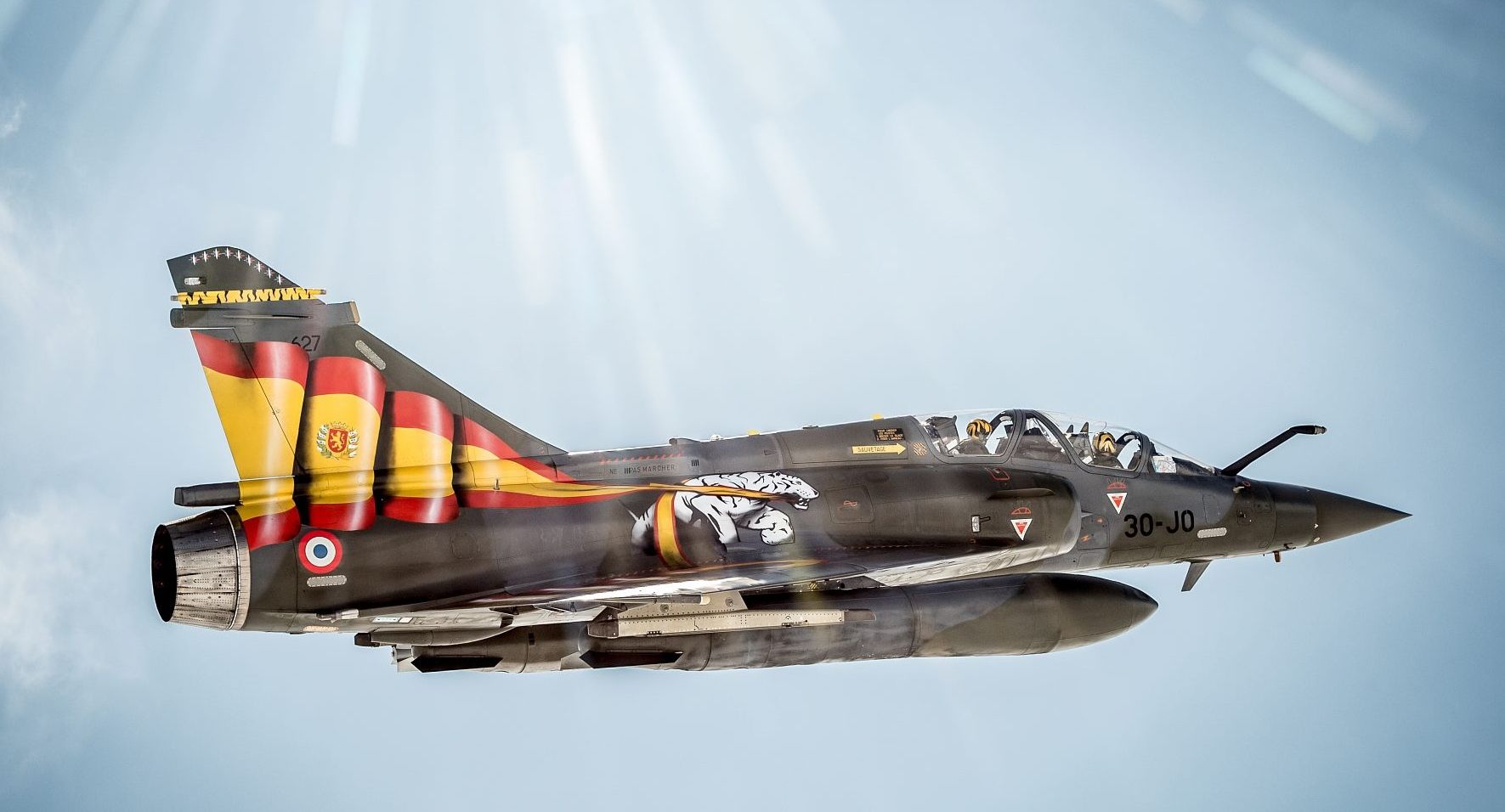
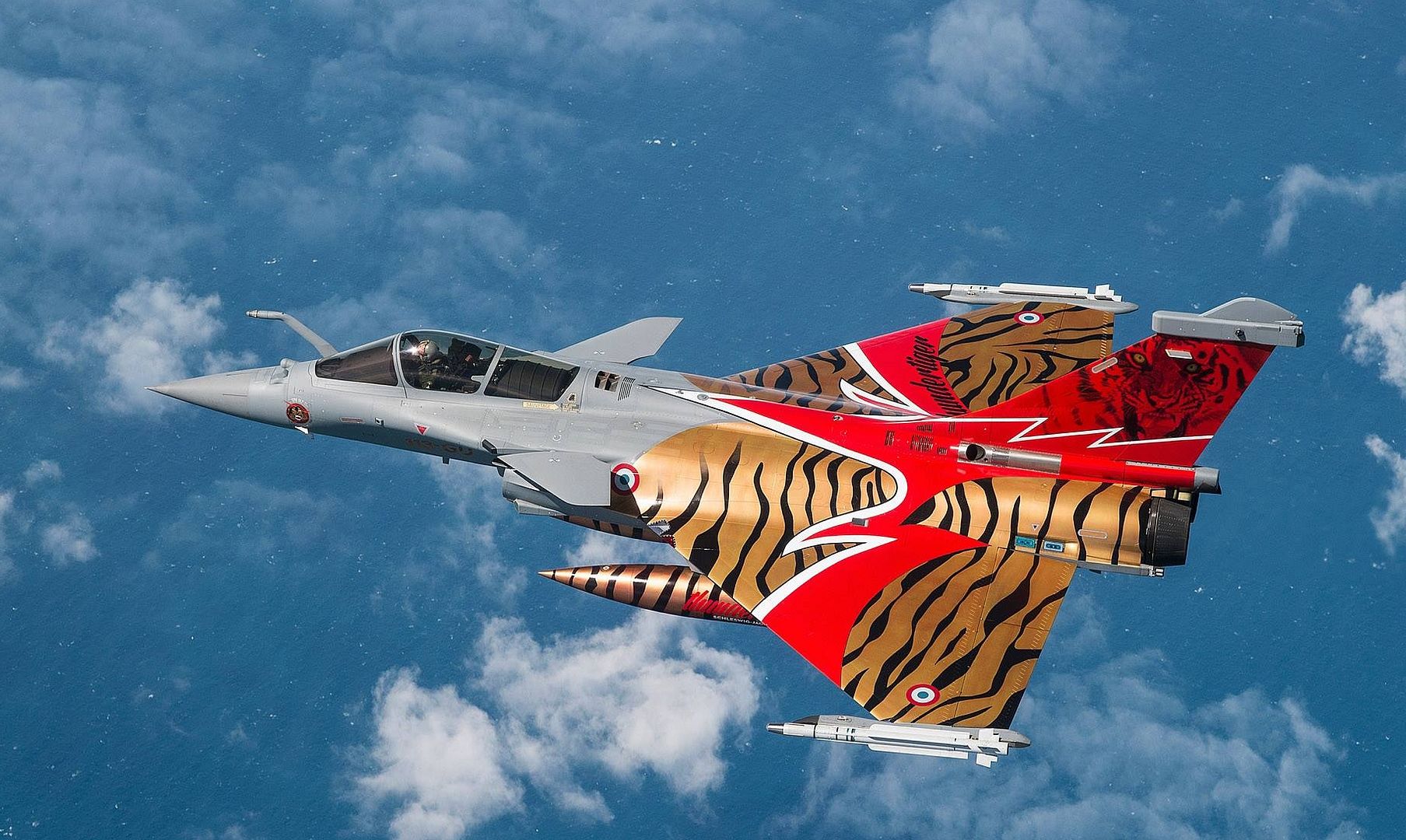
-
 Main AdminA T-33, America's first fighter jet trainer, flies an aerial routine during the Arctic Thunder Open House, July 30, 2016 at Joint Base Elmendorf-Richardson. The biennial event is historically the largest multi-day event in the state and one of the premier aerial demonstrations in the world. The event features more than 40 key performers and ground acts to include the JBER joint forces, U.S. Air Force F-22, and U.S. Navy Blue Angels demonstrations teams. (U.S. Air Force photo by Senior Airman James Richardson)
Main AdminA T-33, America's first fighter jet trainer, flies an aerial routine during the Arctic Thunder Open House, July 30, 2016 at Joint Base Elmendorf-Richardson. The biennial event is historically the largest multi-day event in the state and one of the premier aerial demonstrations in the world. The event features more than 40 key performers and ground acts to include the JBER joint forces, U.S. Air Force F-22, and U.S. Navy Blue Angels demonstrations teams. (U.S. Air Force photo by Senior Airman James Richardson)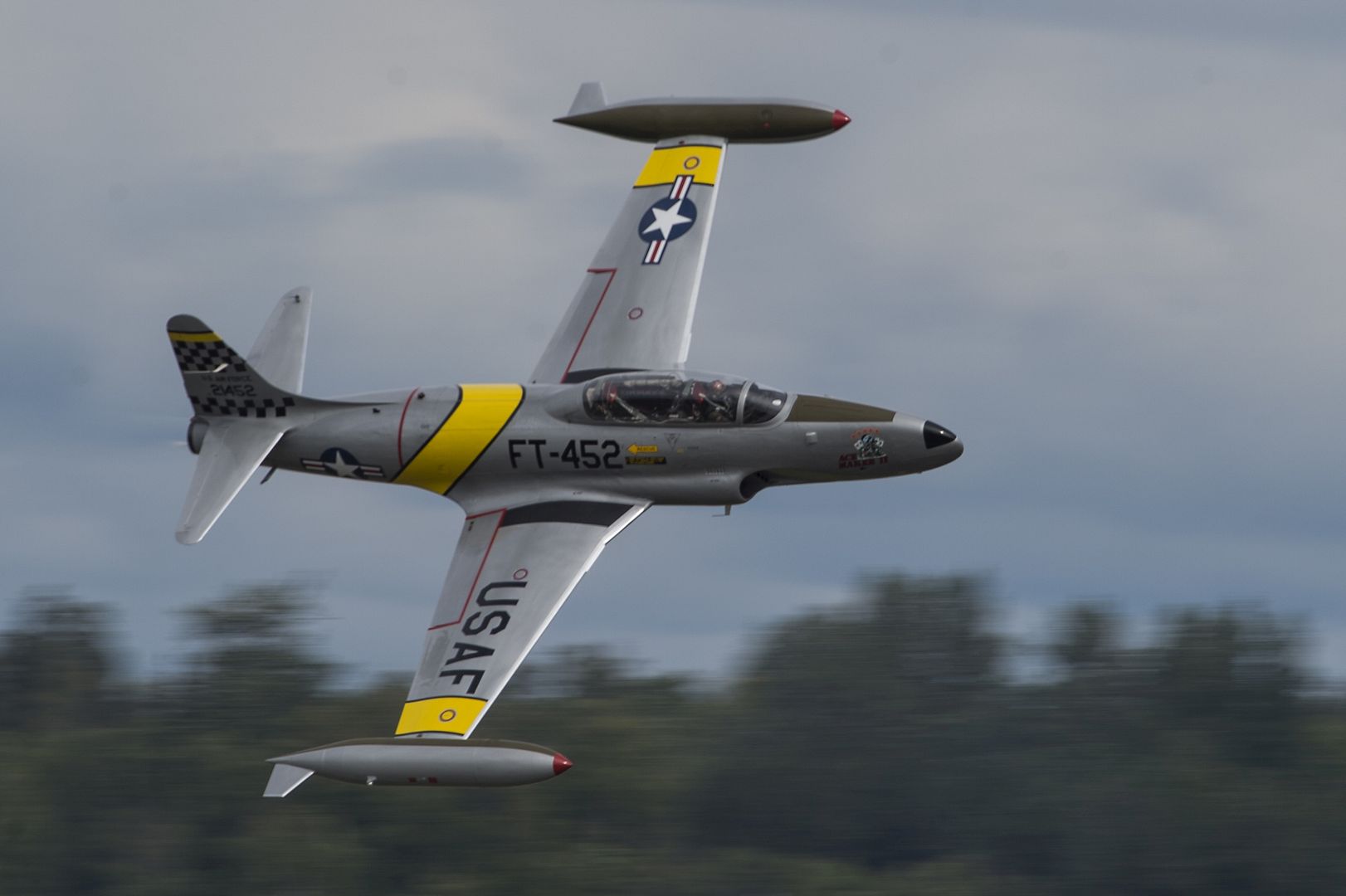
Eric Hansen, and Ken Fowler of Team Rocket make a close high-speed pass during the Arctic Thunder Open House. The biennial event is historically the largest multi-day event in the state and one of the premier aerial demonstrations in the world. Arctic Thunder will open its doors to the public, featuring more than 40 key performers and ground acts, July 30 and 31. (U.S. Air Force photo/Justin Connaher)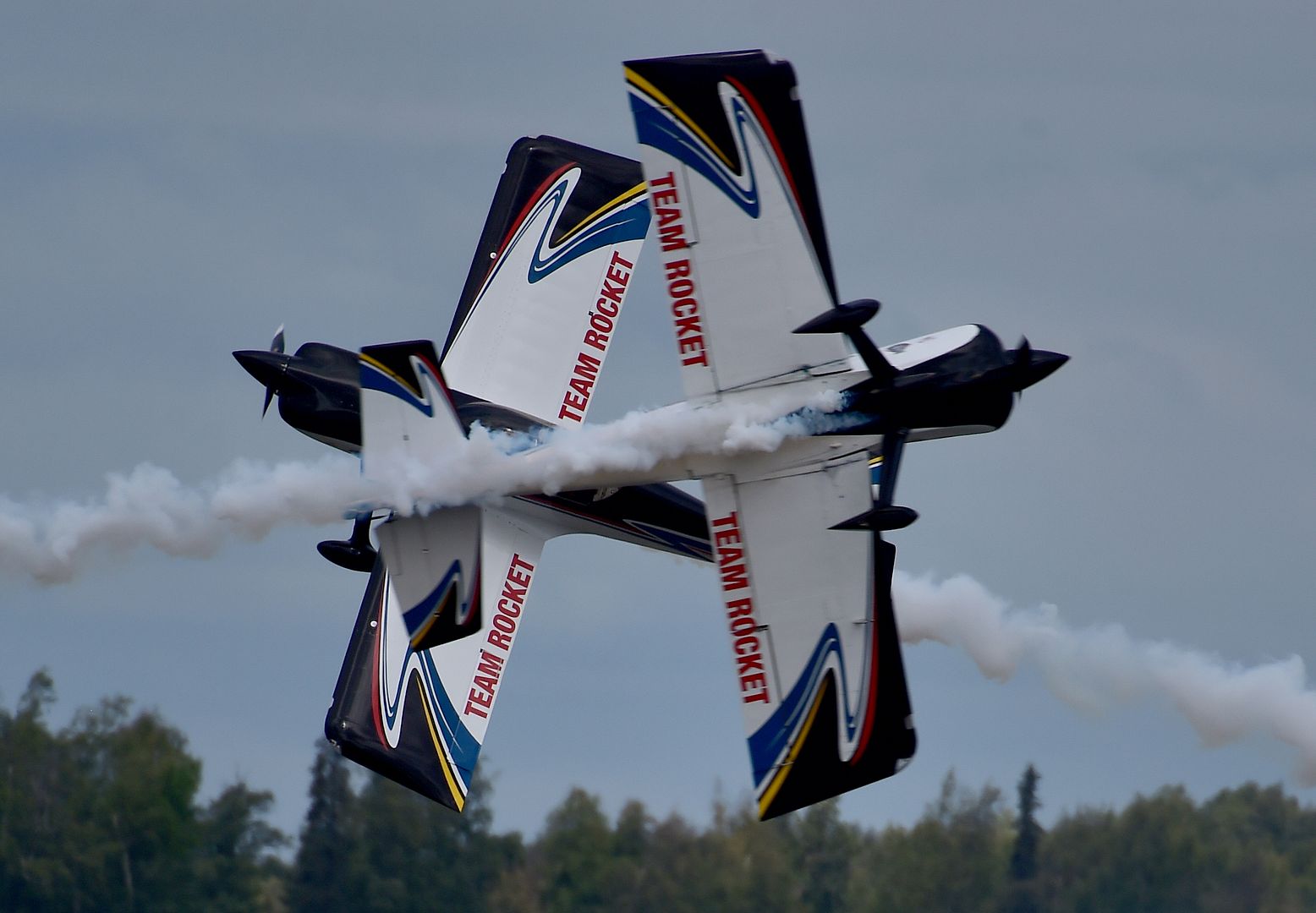
A U.S. Air Force F-22 Raptor takes off during the Arctic Thunder Open House at Joint Base Elmendorf-Richardson, Alaska on July 30, 2016. The biennial event is historically the largest multi-day event in the state and one of the premier aerial demonstrations in the world. Arctic Thunder will open its doors to the public, featuring more than 40 key performers and ground acts, July 30 and 31. (U.S. Air Force photo's/Alejandro Pena)
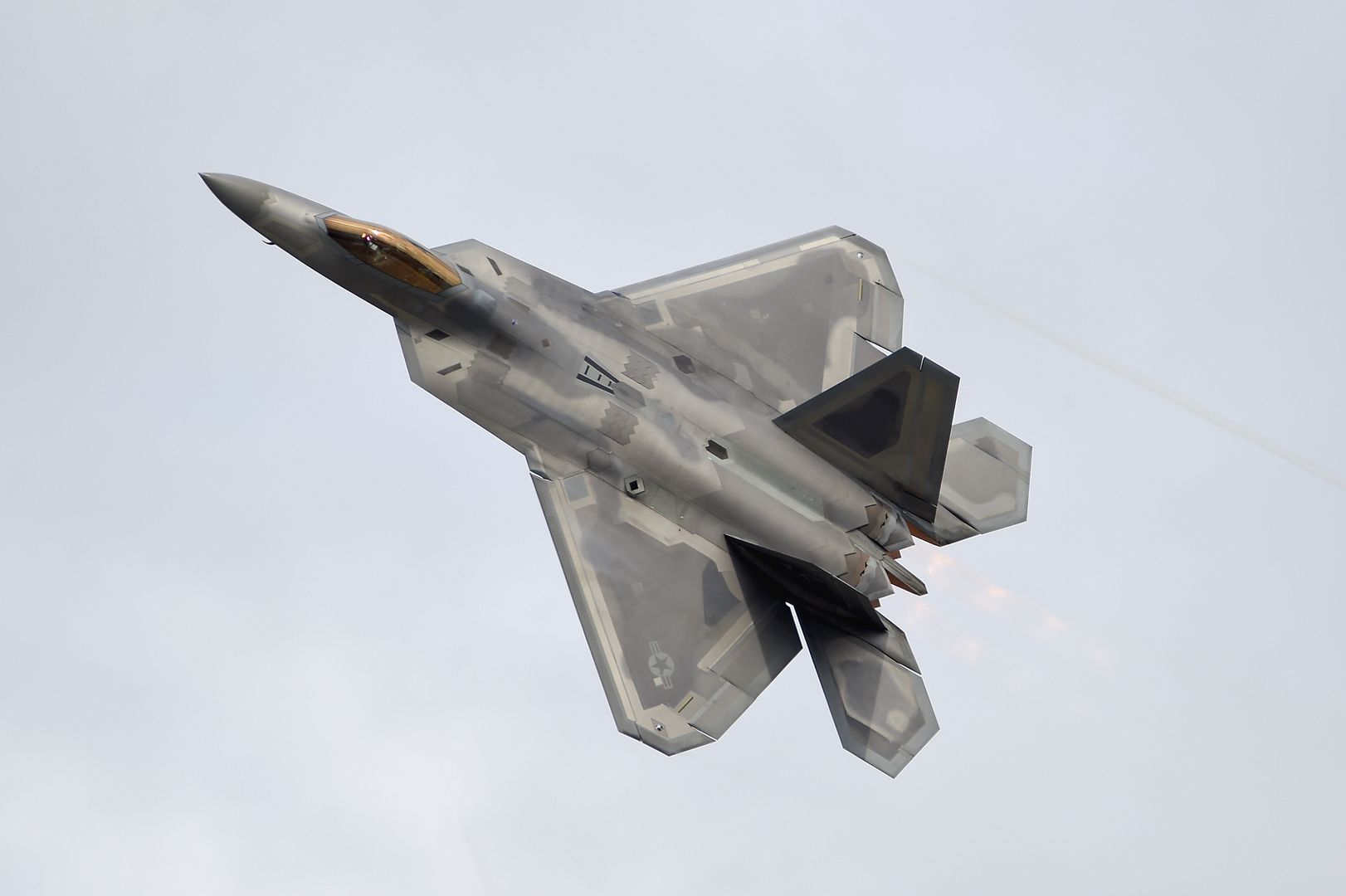
Maj. Dan "Rock" Dickinson, F-22 Raptor Demonstration Team pilot from Joint Base Langley-Eustis, Va., does a high speed pass with the bomb bay door open during Arctic Thunder Open House 2016 at Joint Base Elmendorf-Richardson, Alaska, July 30, 2016. The demonstration team performs precision aerial maneuvers to demonstrate the unique capabilities of the world's only operational fifth-generation fighter aircraft. (U.S. Air Force photo by Staff Sgt. Sheila deVera)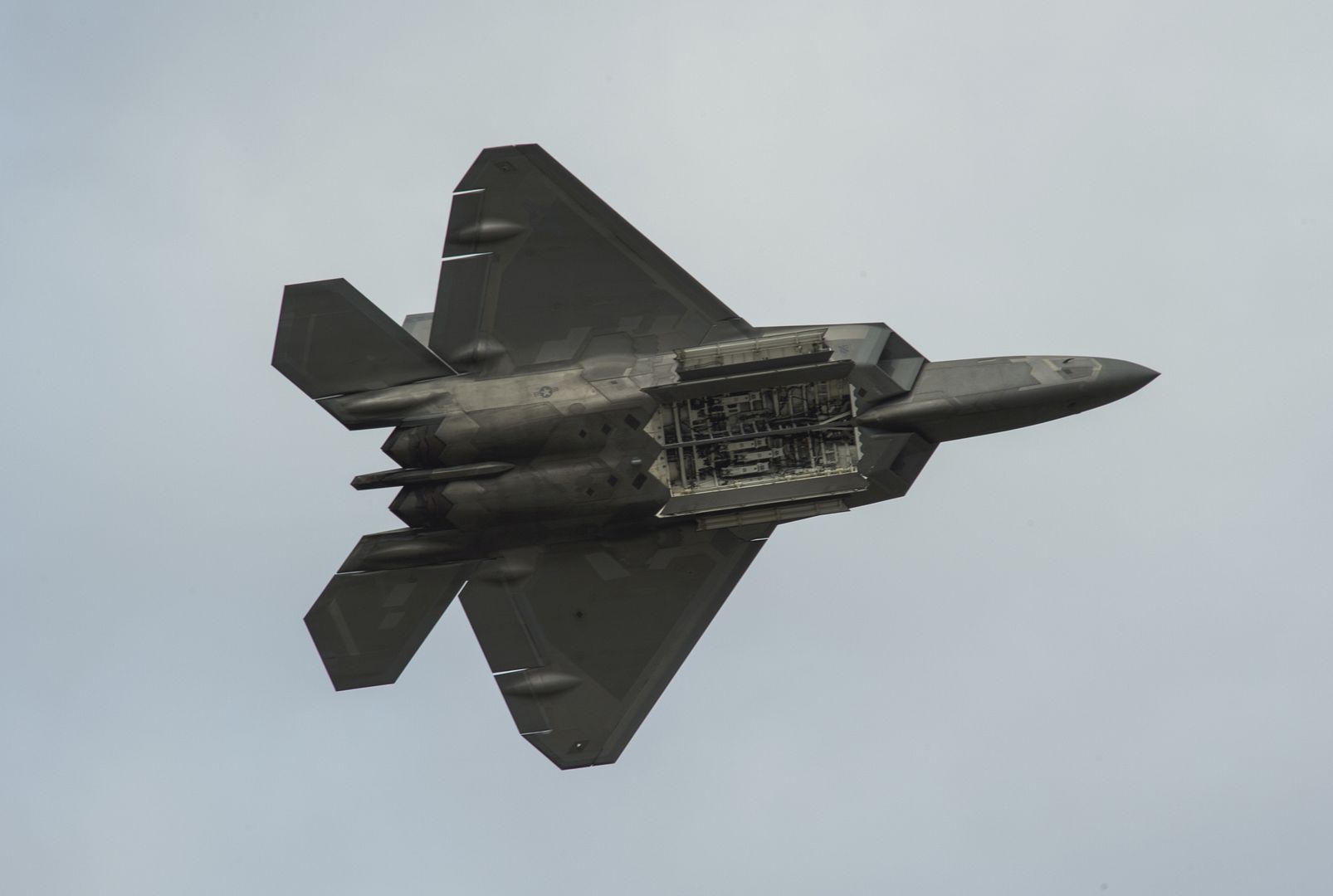
A U.S. Air Force F-16 Fighting Falcon, assigned to the 18th Aggressor Squadron out of Eielson Air Force Base, takes off during the Arctic Thunder Open House at Joint Base Elmendorf-Richardson, Alaska, on July 31, 2016. The biennial event is historically the largest multi-day event in the state and one of the premier aerial demonstrations in the world. Arctic Thunder featured more than 40 key performers and ground acts, July 30 and 31. (U.S. Air Force photo/Alejandro Pena)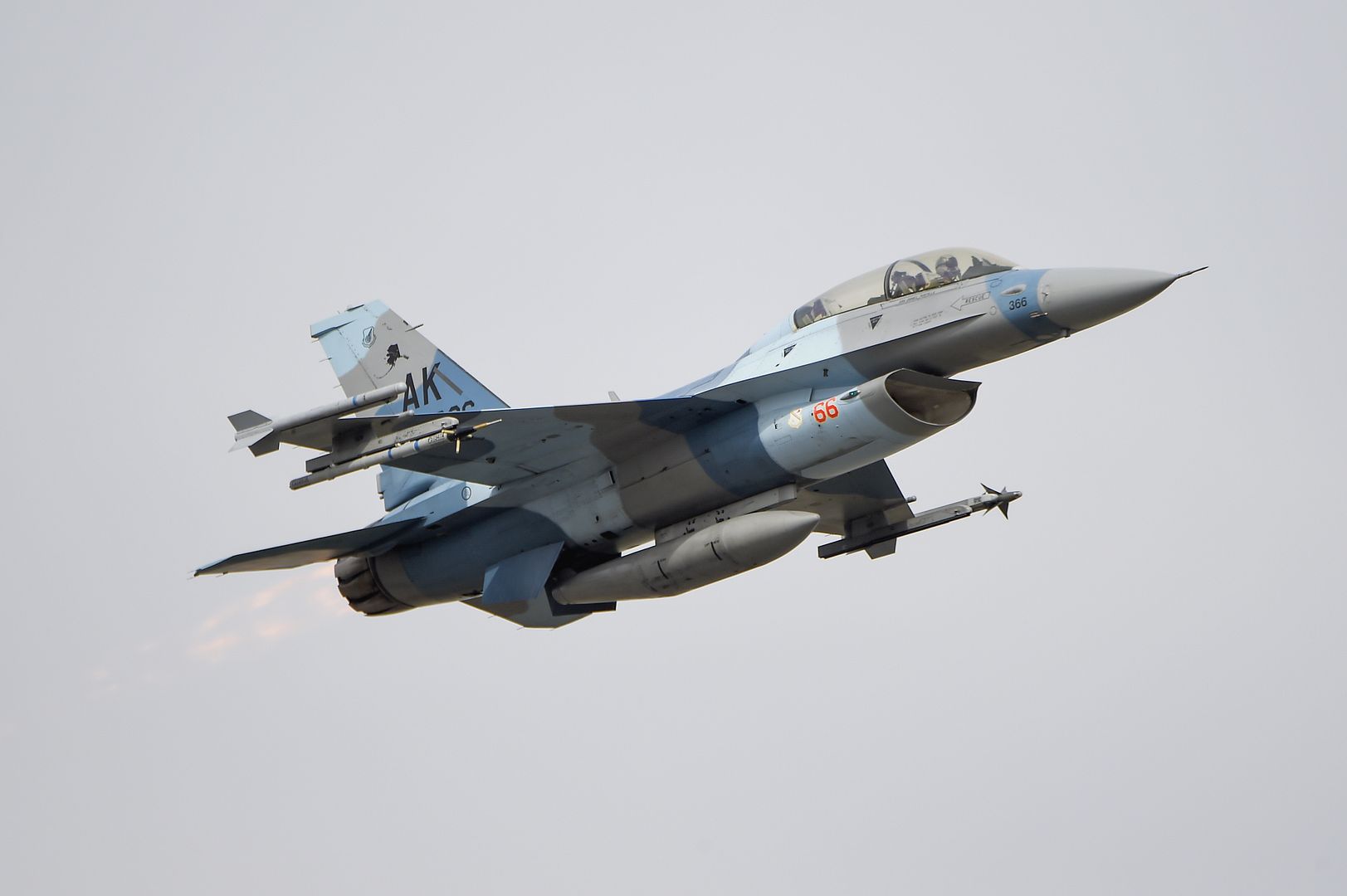
U.S. Navy F/A-18 Hornets pilots, assigned to the Flight Demonstration Squadron, the Blue Angels, perform precision formation flying and aerobatics during the Arctic Thunder Open House at Joint Base Elmendorf-Richardson, Alaska on July 31, 2016. The biennial event is historically the largest multi-day event in the state and one of the premier aerial demonstrations in the world. Arctic Thunder featured more than 40 key performers and ground acts, July 30 and 31. (U.S. Air Force photo/Alejandro Pena)
MARINE CORPS BASE HAWAII (July 30, 2016) A U.S. Marine Corps AH-1W Super Cobra with Marine Light Attack Helicopter Squadron (HMLA) 367, Marine Aircraft Group 24, supports a beach assault during Rim of the Pacific 2016. Twenty-six nations, more than 40 ships and submarines, more than 200 aircraft and 25,000 personnel are participating in RIMPAC from June 30 to Aug. 4, in and around the Hawaiian Islands and Southern California. The world's largest international maritime exercise, RIMPAC provides a unique training opportunity that helps participants foster and sustain the cooperative relationship that are critical to ensuring the safety of sea lanes and security on the world's oceans. RIMPAC 2016 is the 25th exercise in the series that began in 1971. (U.S. Navy photo by Mass Communication Specialist 2nd Class Katarzyna Kobiljak)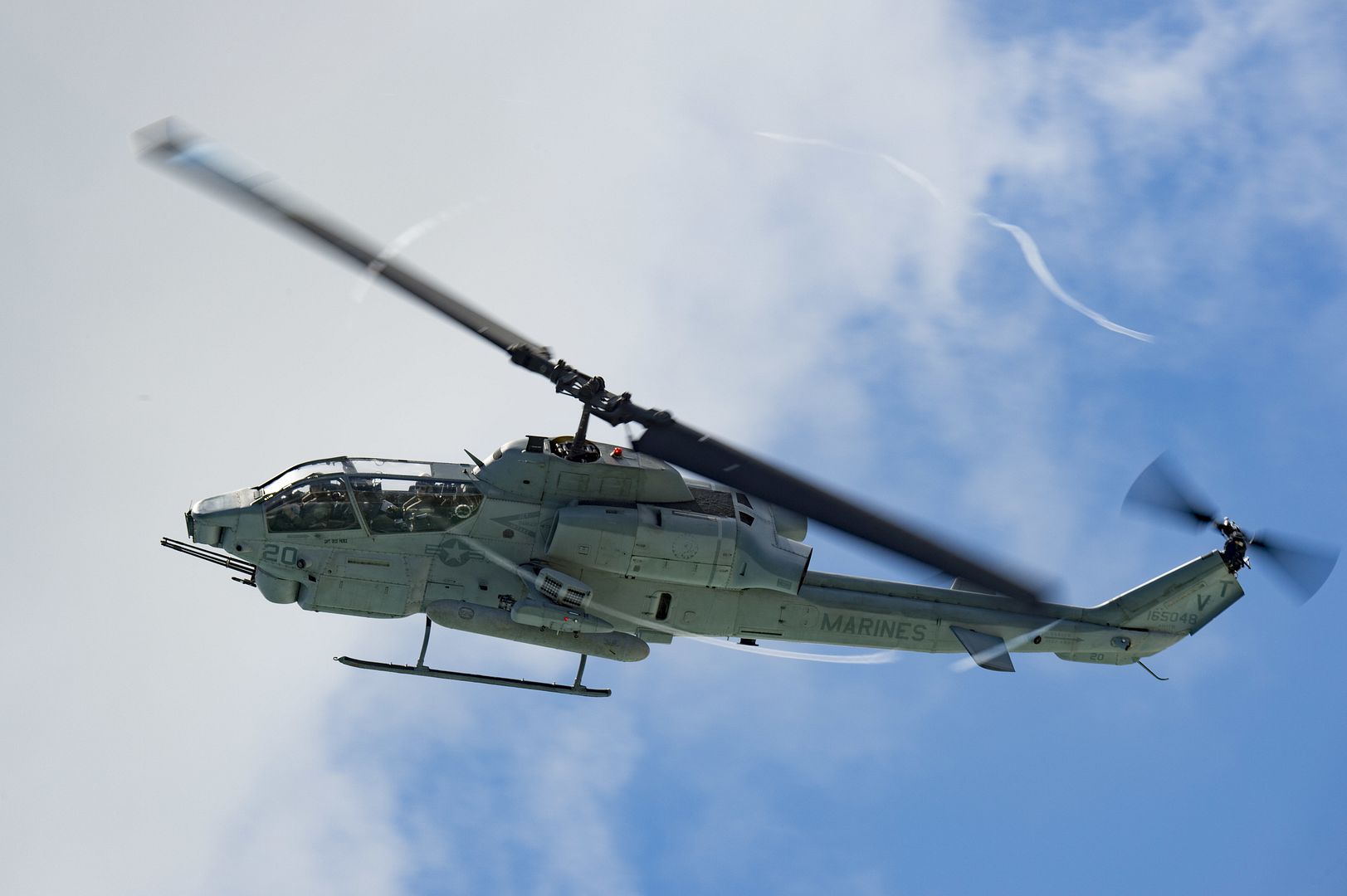
Darwin Exercise Pitch Black 2016 kicks off.
A Republic of Singapore Air Force G550 Conformal Airborne Early Warning (CAEW) aircraft lands at RAAF Base Darwin as part of Exercise Pitch Black 2016.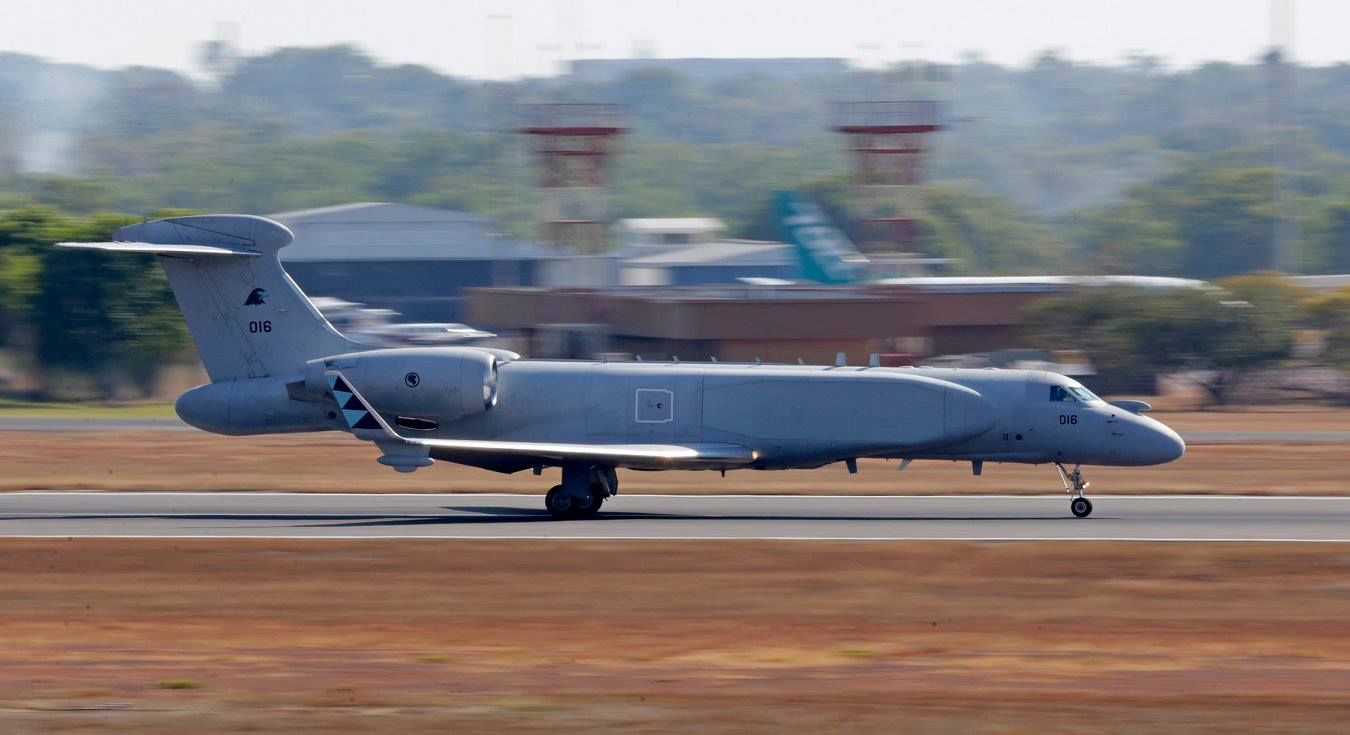
A Republic of Singapore Air Force F-16 taxis at RAAF Base Darwin as part of Exercise Pitch Black 2016.
A Republic of Singapore Air Force F-16 taxis at RAAF Base Darwin as part of Exercise Pitch Black 2016.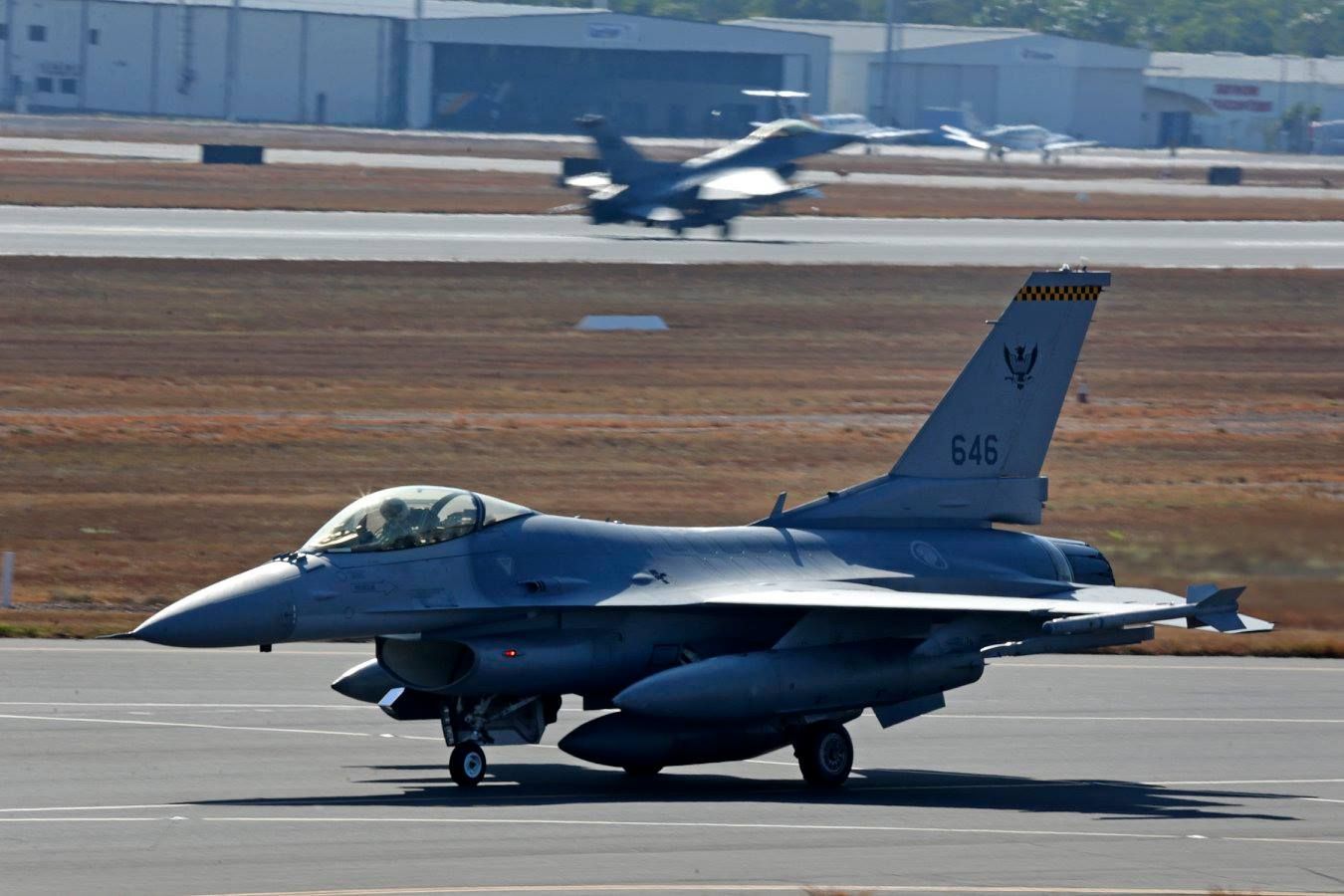
A United States Air Force F-16C taxis into RAAF Base Darwin as part of Exercise Pitch Black 2016. ? in Darwin, Northern Territory.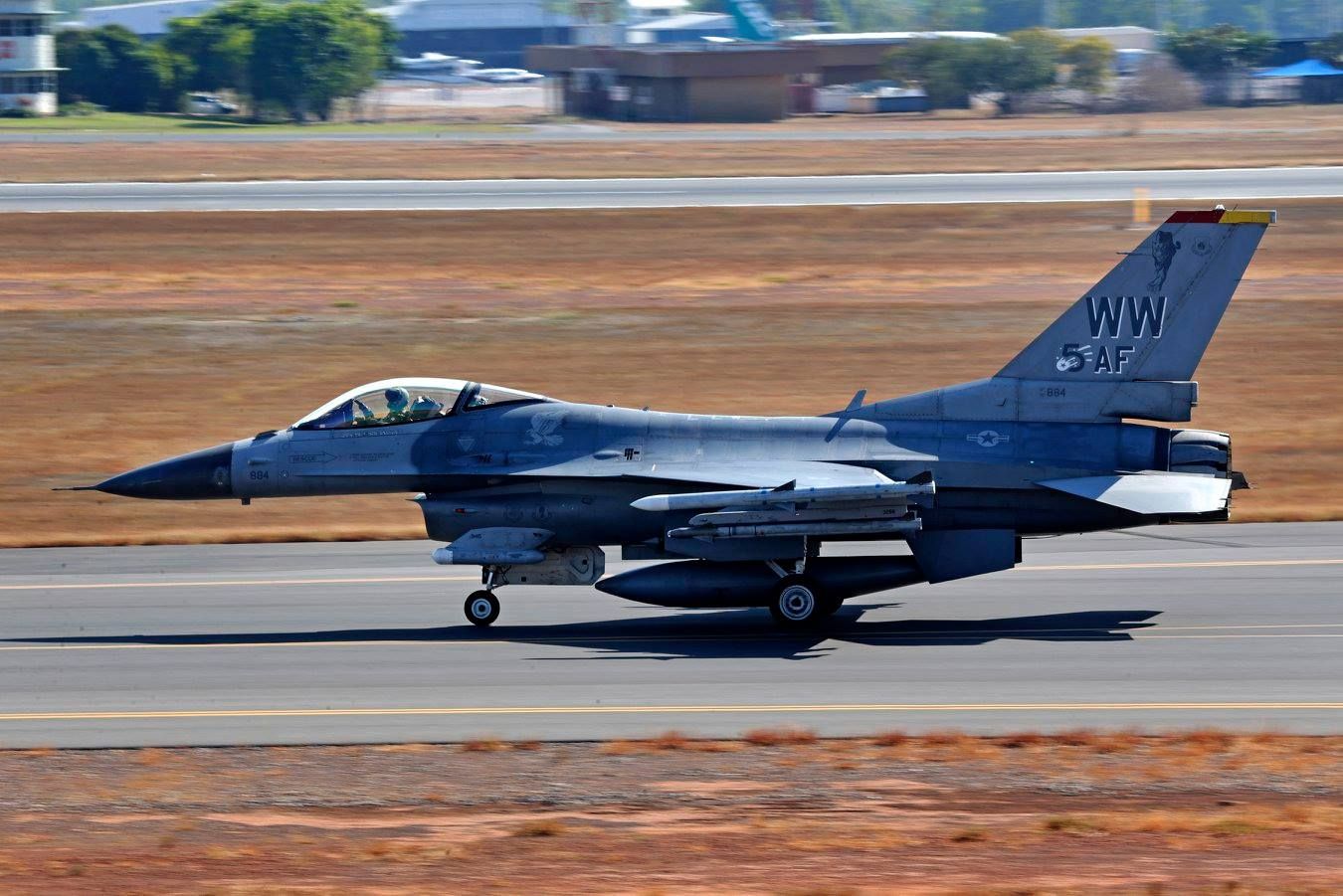
A RAAF F/A-18A Hornet taxis out of RAAF Base Darwin as part of Exercise Pitch Black 2016. ? in Darwin, Northern Territory.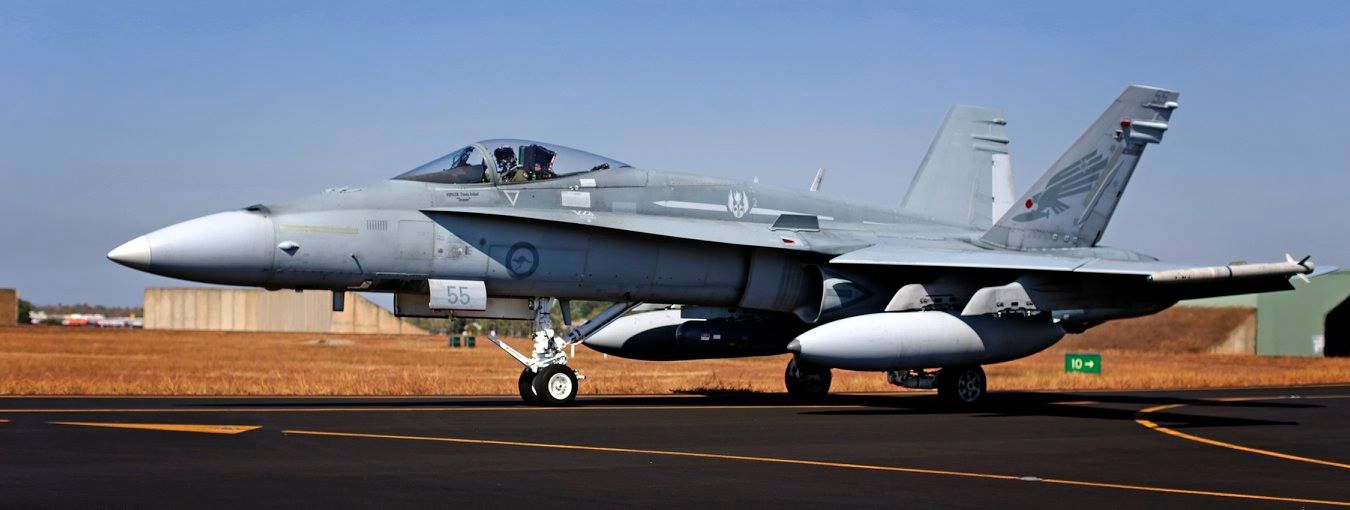
A Republic of Singapore Air Force F-15 taxis at RAAF Base Darwin as part of Exercise Pitch Black 2016. ? in Darwin, Northern Territory.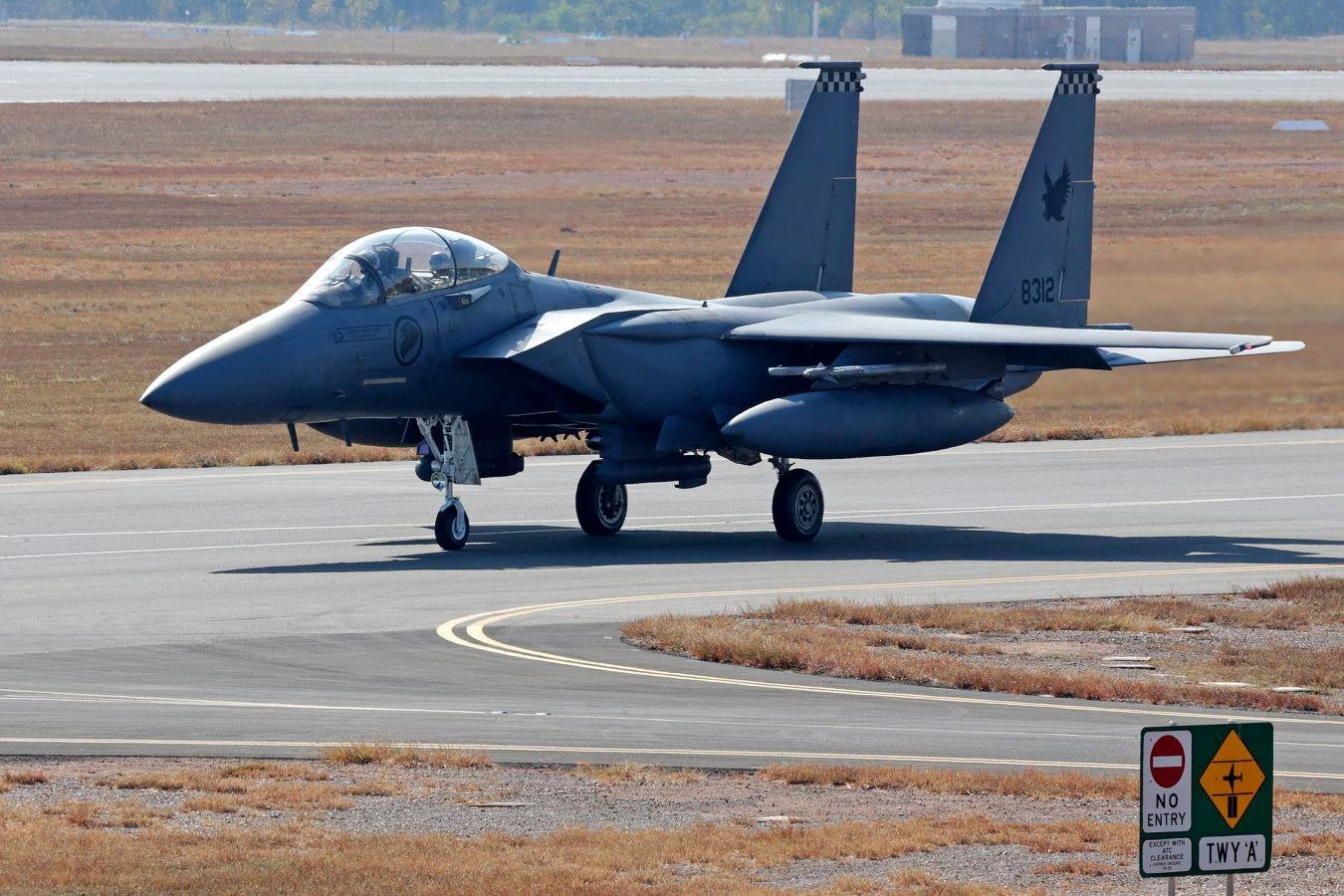
-
 Main AdminJOINT BASE LANGLEY-EUSTIS, Va. (AFNS) -- The F-35A Lightning II fifth-generation fighter aircraft was declared ?combat ready? by Gen. Hawk Carlisle, the commander of Air Combat Command, Aug 2.
Main AdminJOINT BASE LANGLEY-EUSTIS, Va. (AFNS) -- The F-35A Lightning II fifth-generation fighter aircraft was declared ?combat ready? by Gen. Hawk Carlisle, the commander of Air Combat Command, Aug 2.
Carlisle lauded the aircraft?s performance, noting that the aircraft had met all key criteria for reaching initial operational capability: Airmen trained, manned and equipped to conduct basic close air support, interdiction and limited suppression/destruction of enemy air defenses in a contested environment with an operational squadron of 12-24 aircraft; the ability to deploy and conduct operational missions using program of record weapons and missions systems; and having all necessary logistics and operational elements in place.
?I am proud to announce this powerful new weapons system has achieved initial combat capability,? Carlisle said. ?The F-35A will be the most dominant aircraft in our inventory because it can go where our legacy aircraft cannot and provide the capabilities our commanders need on the modern battlefield.?
The F-35A is the latest addition to ACC?s fleet of deployable and fifth-generation aircraft. It provides air superiority, interdiction, suppression of enemy air defenses and close air support as well as great command and control functions through fused sensors, and it will provide pilots with unprecedented situational awareness of the battlespace that will be more extensive than any single-seat platform in existence.
?Bringing the F-35A to initial combat readiness is a testament to our phenomenal Airmen and the outstanding support of the Joint Program Office and our enterprise partners. This important milestone for our fighter force ensures the United States, along with our allies and international partners, remains prepared to deter, deny, and defeat the full spectrum of growing threats around the globe," added Air Force Secretary Deborah Lee James.
Chief of Staff of the Air Force Gen. David L. Goldfein, said that dynamic new capability will benefit the joint warfighter.
"The combat ready F-35A is the latest fifth-generation fighter aircraft in the Air Force's inventory and provides our nation air dominance in any environment. The F-35A brings an unprecedented combination of lethality, survivability, and adaptability to joint and combined operations, and is ready to deploy and strike well-defended targets anywhere on Earth," Goldfein said. "Today's declaration of IOC is an important milestone on the road to achieving full warfighting capability for the F-35A.?
The 34th Fighter Squadron of the 388th Fighter Wing, based at Hill Air Force Base, Utah, is the service?s first operational F-35A squadron, having met all the established criteria for initial operational capability including a successful June deployment to Mountain Home AFB, Idaho, and a series of eight-aircraft sorties held in mid-July. 34th FS Airmen will fly and maintain the F-35A alongside Air Force Reservists from Hill?s 419th Fighter Wing.
"Our Airmen have worked tirelessly to make sure our aircraft are combat ready: meeting challenges head-on and completing all the required milestones," said Col. David Lyons, the 388th Fighter Wing commander. "We're very proud that the Air Force has declared us combat ready and we're prepared to take this aircraft wherever it's needed in support of our national defense."
Those sentiments were echoed by Col. David Smith, the 419th FW commander. ?It's an honor to fly and maintain the F-35 with our active-duty counterparts here at Hill,? Smith said. ?Our units were the first to fly combat-ready F-16s nearly 40 years ago, and we're very proud to have made history once again in bringing the Air Force's newest fighter jet to IOC.?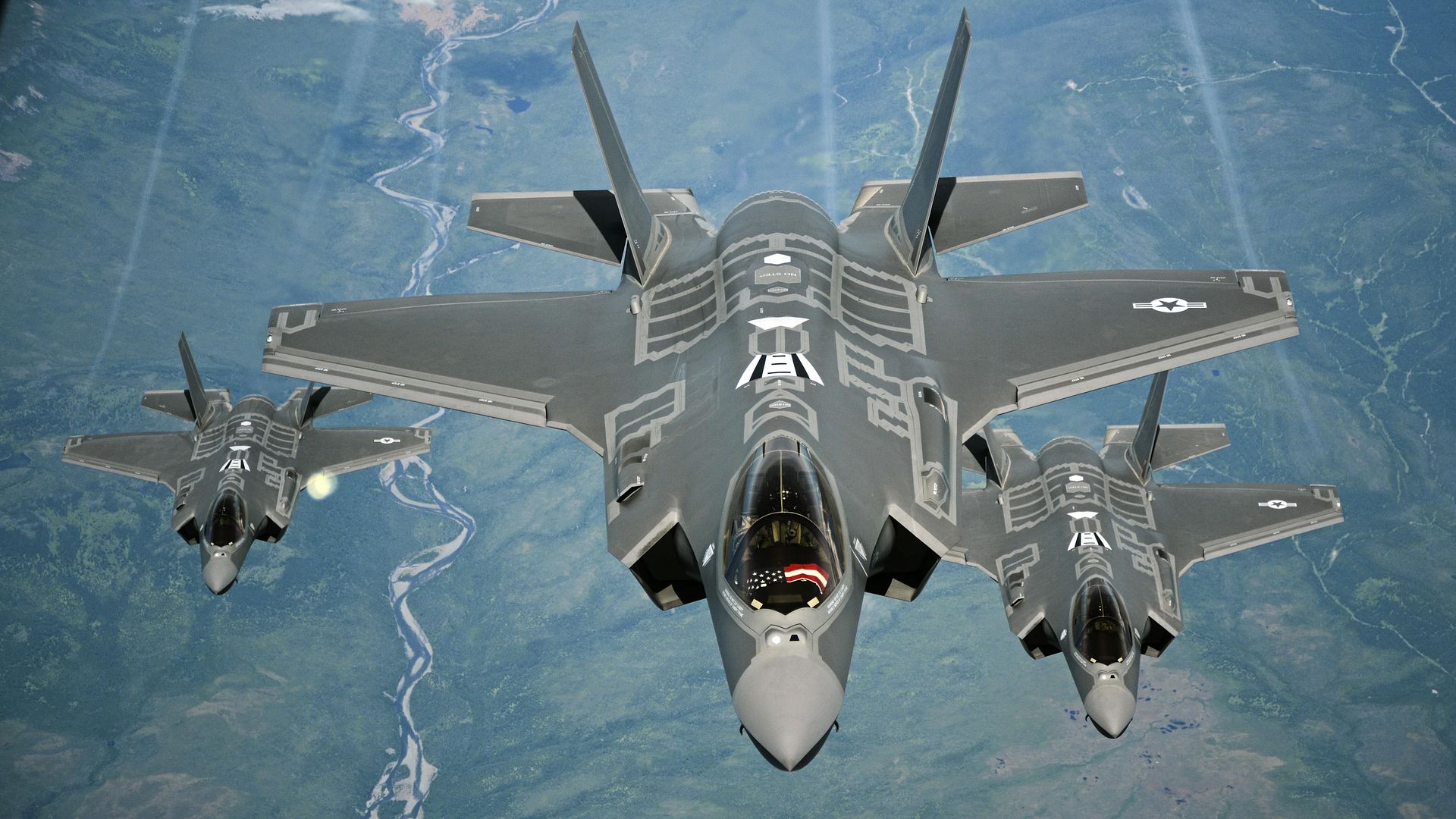
ARABIAN GULF (July 31, 2016) ? An F/A-18C Hornet assigned to the Wildcats of Strike Fighter Squadron (VFA) 131 prepares to launch from the flight deck of the aircraft carrier USS Dwight D. Eisenhower (CVN 69) (Ike). Ike and its Carrier Strike Group are deployed in support of Operation Inherent Resolve, maritime security operations and theater security cooperation efforts in the U.S. 5th Fleet area of operations. (U.S. Navy photo's by Mass Communication Specialist 3rd Class J. Alexander Delgado/Released)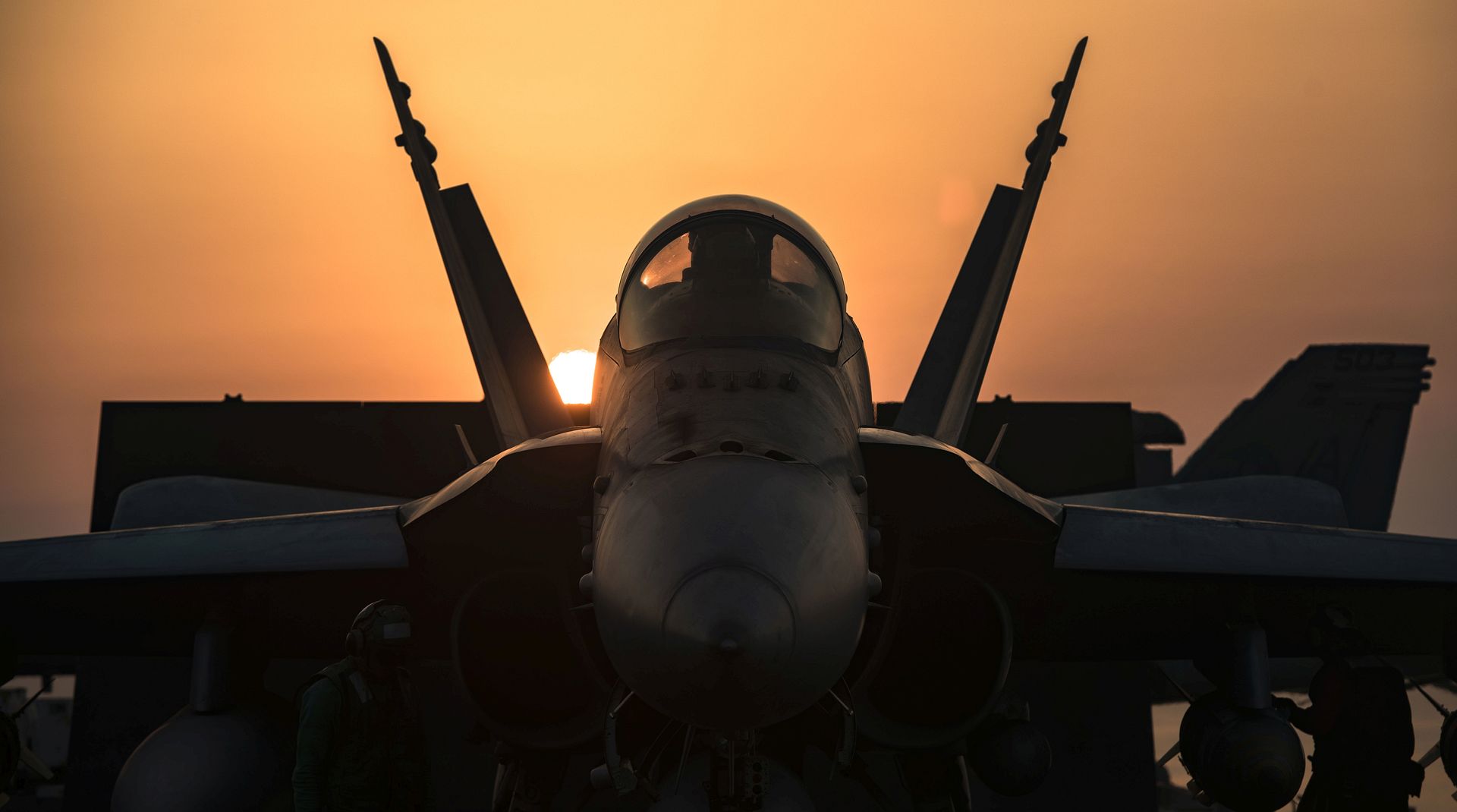
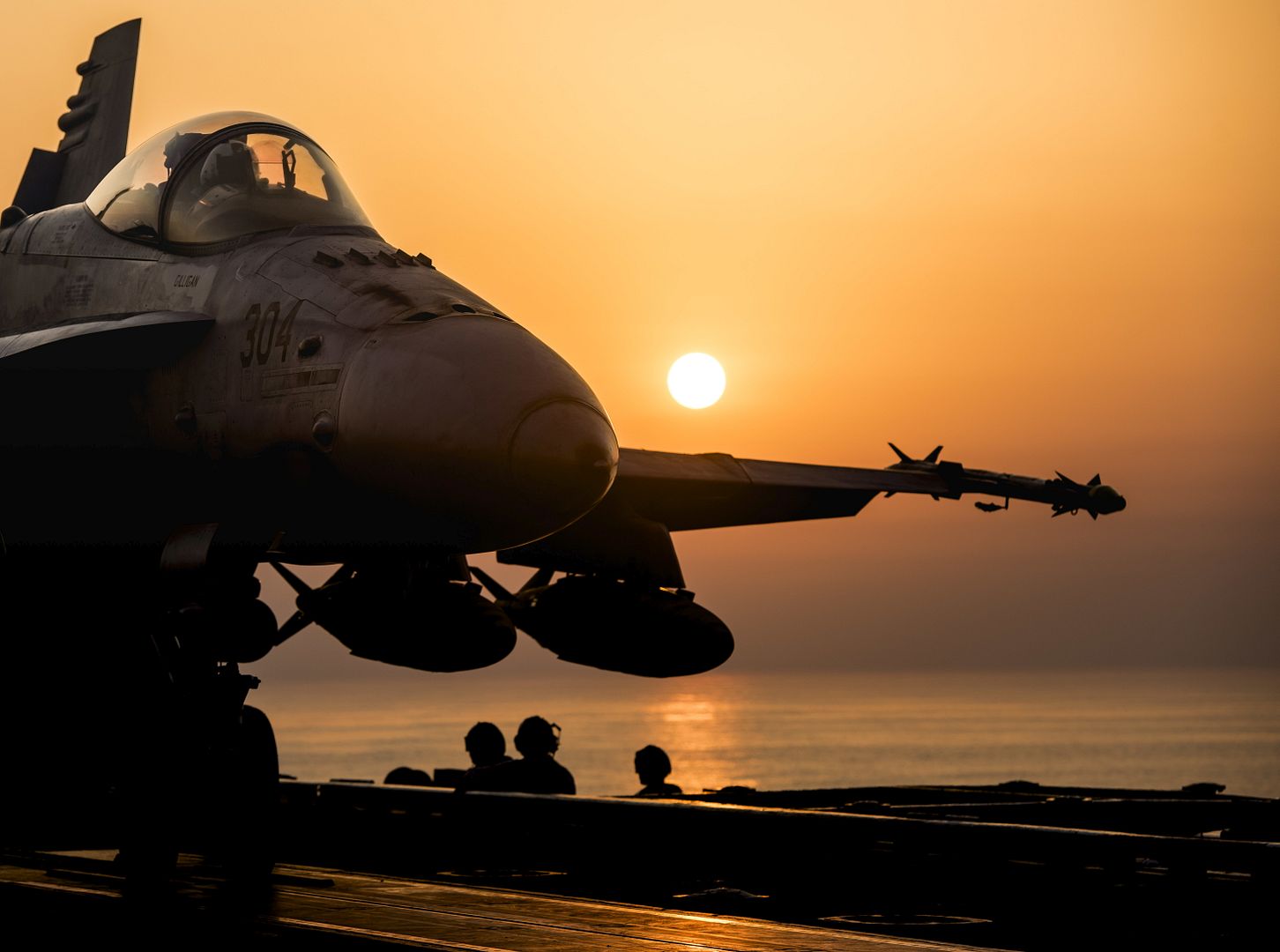
ARABIAN GULF (July 31, 2016) ? An F/A-18E Super Hornet assigned to the Gunslingers of Strike Fighter Squadron (VFA) 105 taxis across the flight deck of the aircraft carrier USS Dwight D. Eisenhower (CVN 69) (Ike). Ike and its Carrier Strike Group are deployed in support of Operation Inherent Resolve, maritime security operations and theater security cooperation efforts in the U.S. 5th Fleet area of operations. (U.S. Navy photo by Mass Communication Specialist 3rd Class Nathan T. Beard/Released)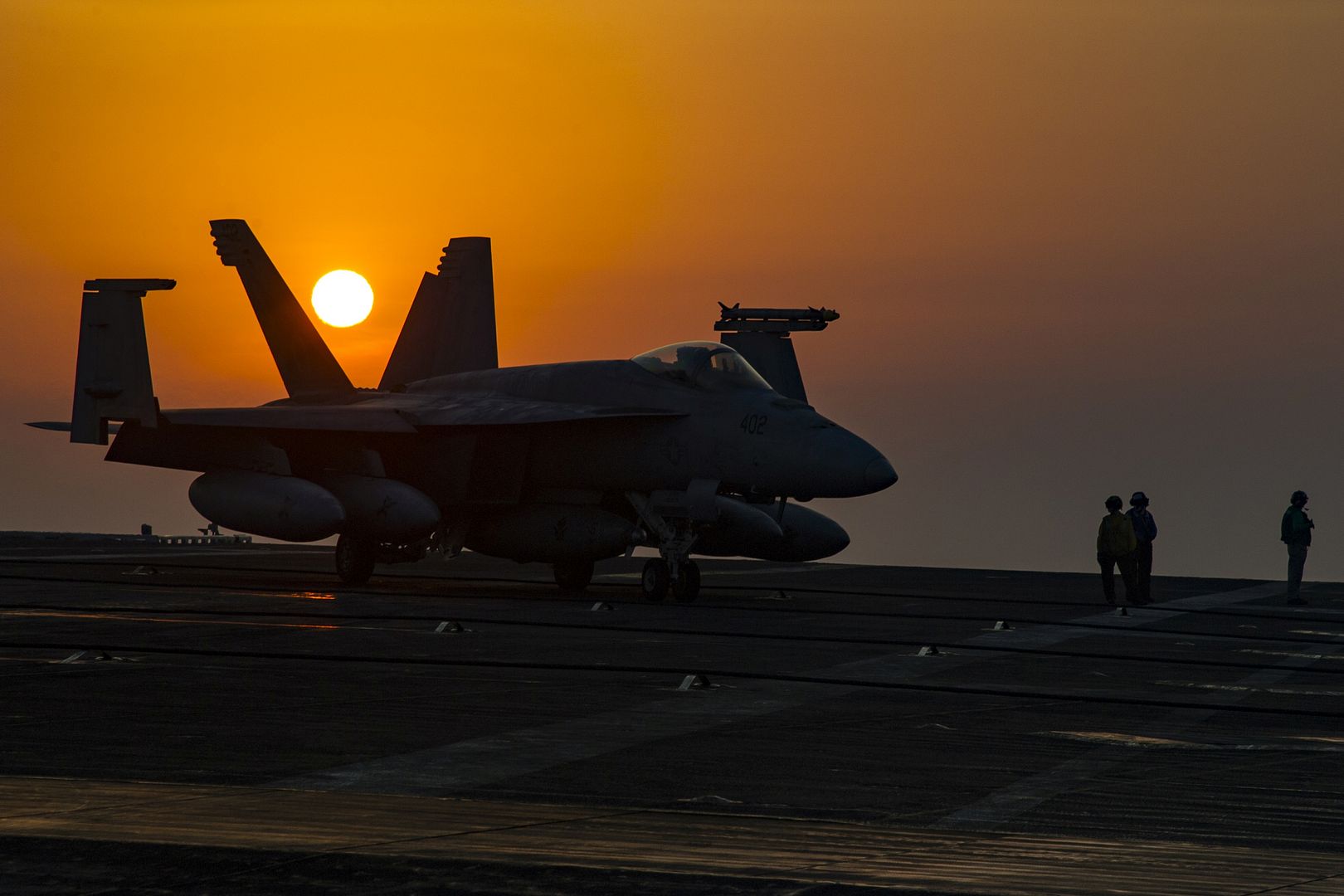
A B-52 Stratofortress from Minot Air Force Base, N.D. receives fuel from a 305th Air Mobility Wing, Joint Base McGuire-Dix-Lakehurst, N.J. during Polar Roar, a strategic deterrence exercise, in the skies near the North Pole, July 31. The rapid global mobility and air refueling capabilities of Air Mobility Command and the 305th Air Mobility Wing, ensured the B-52?s were able to complete their mission. (U.S. Air Force photo's by Senior Airman Joshua King)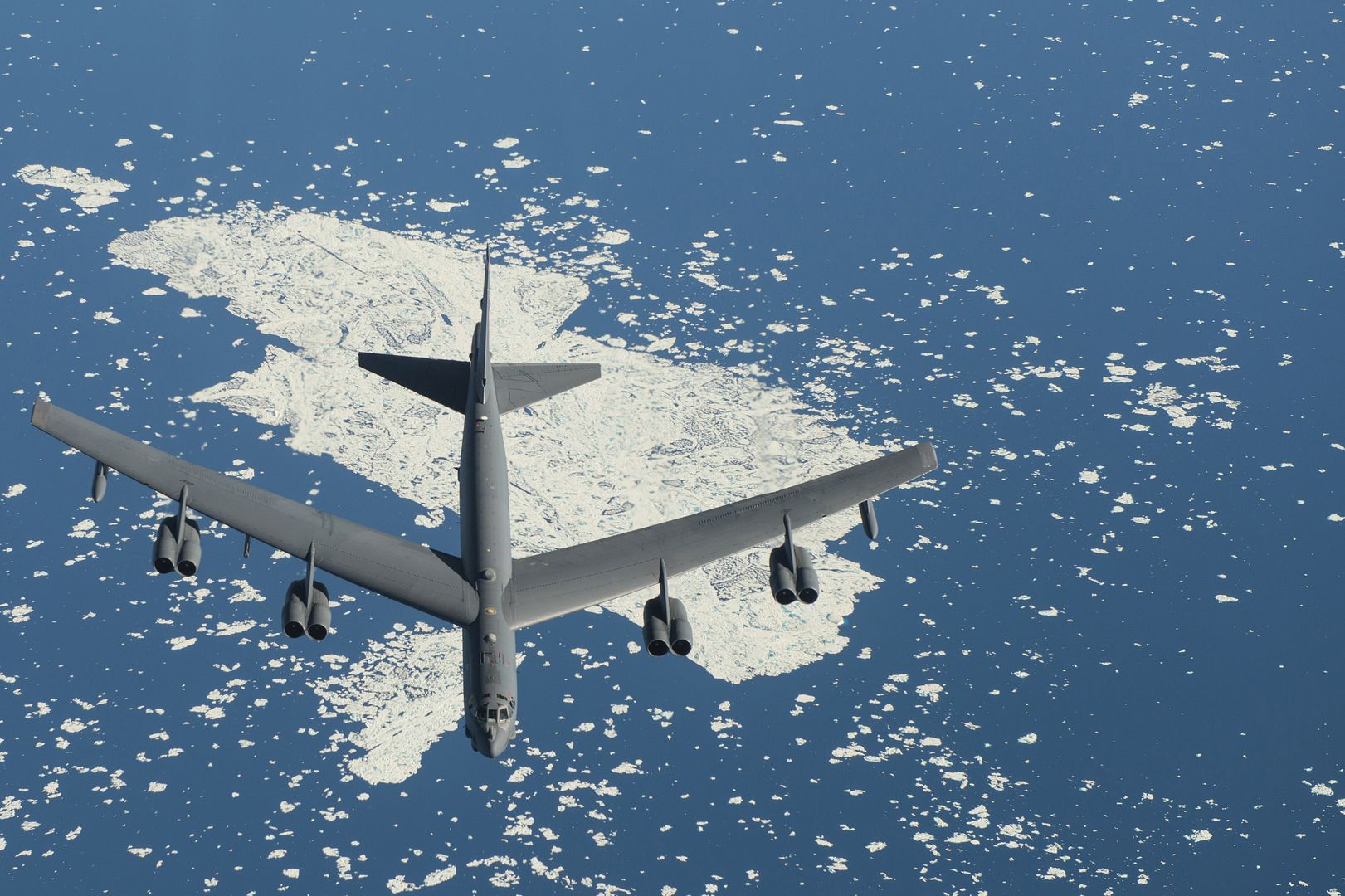

An F/A -18C Hornet with Marine Fighter Attack Squadron (VMFA)122, taxis to the runway to launch air operations during Exercise Pitch Black 2016 at Royal Australian Air Force Base Tindal, Australia, Aug. 1, 2016. Pitch Black 16 is a biennial, three week, multinational, large-force training exercise hosted by RAAF Tindal. The U.S. flying squadron, home based out of Marine Corps Air Station Beaufort, South Carolina, spent the last six months at MCAS Iwakuni, Japan, with the Unit Deployment Program training and preparing for this training evolution. (U.S. Marine Corps photo by Cpl. Nicole Zurbrugg)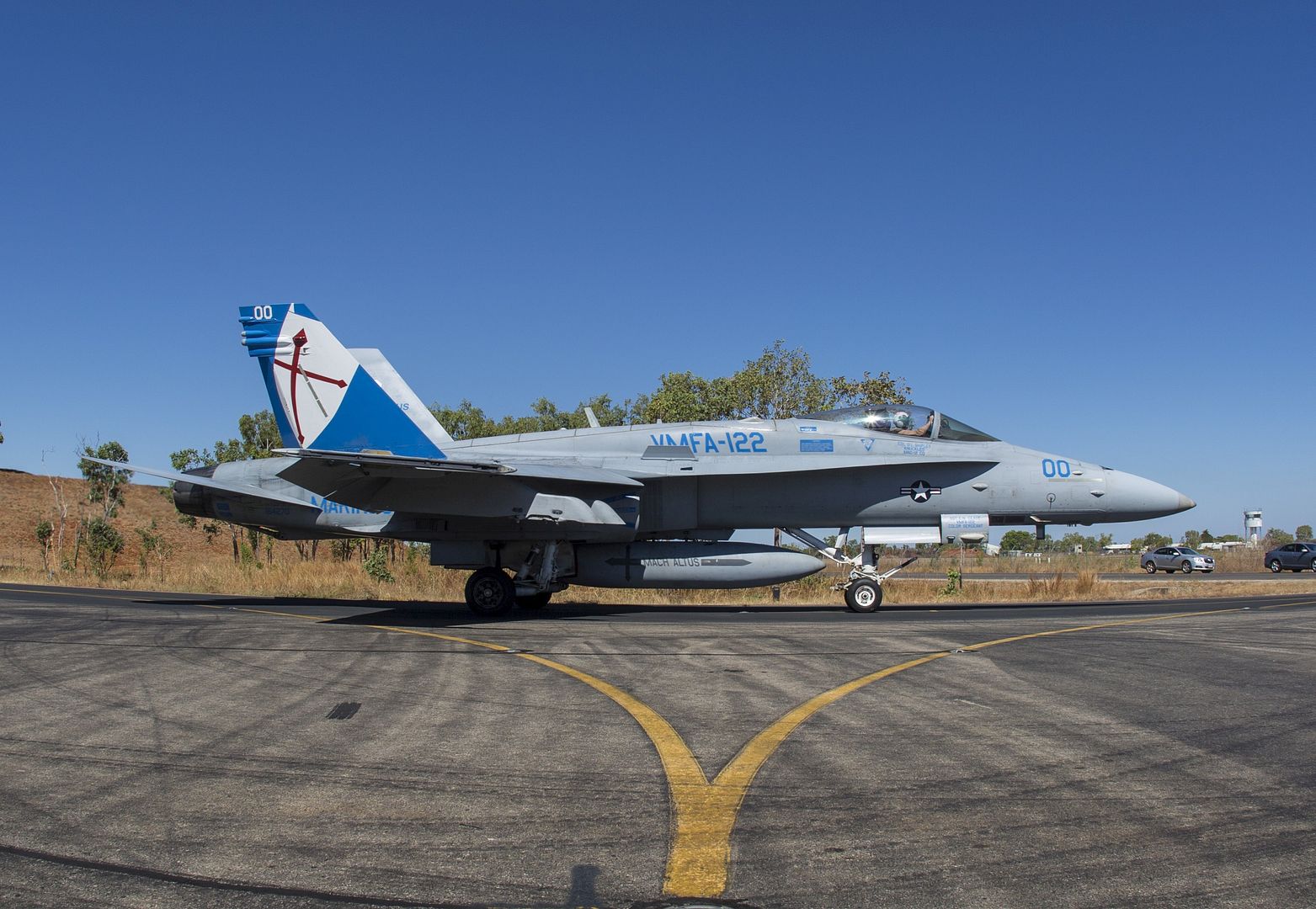
A KC-135 Stratotanker from RAF Mildenhall, England, refuels a B-52 Stratofortress from Minot Air Force Base, N.D., in support of Operation Polar Roar Aug. 1, 2016, over Scotland. Polar Roar is a U.S. Strategic Command operation designed to strengthen bomber crews? interoperability and demonstrate ability for the U.S. bomber force to provide flexible and vigilant long-range global-strike capability. (U.S. Air Force photo's by Staff Sgt. Kate Thornton)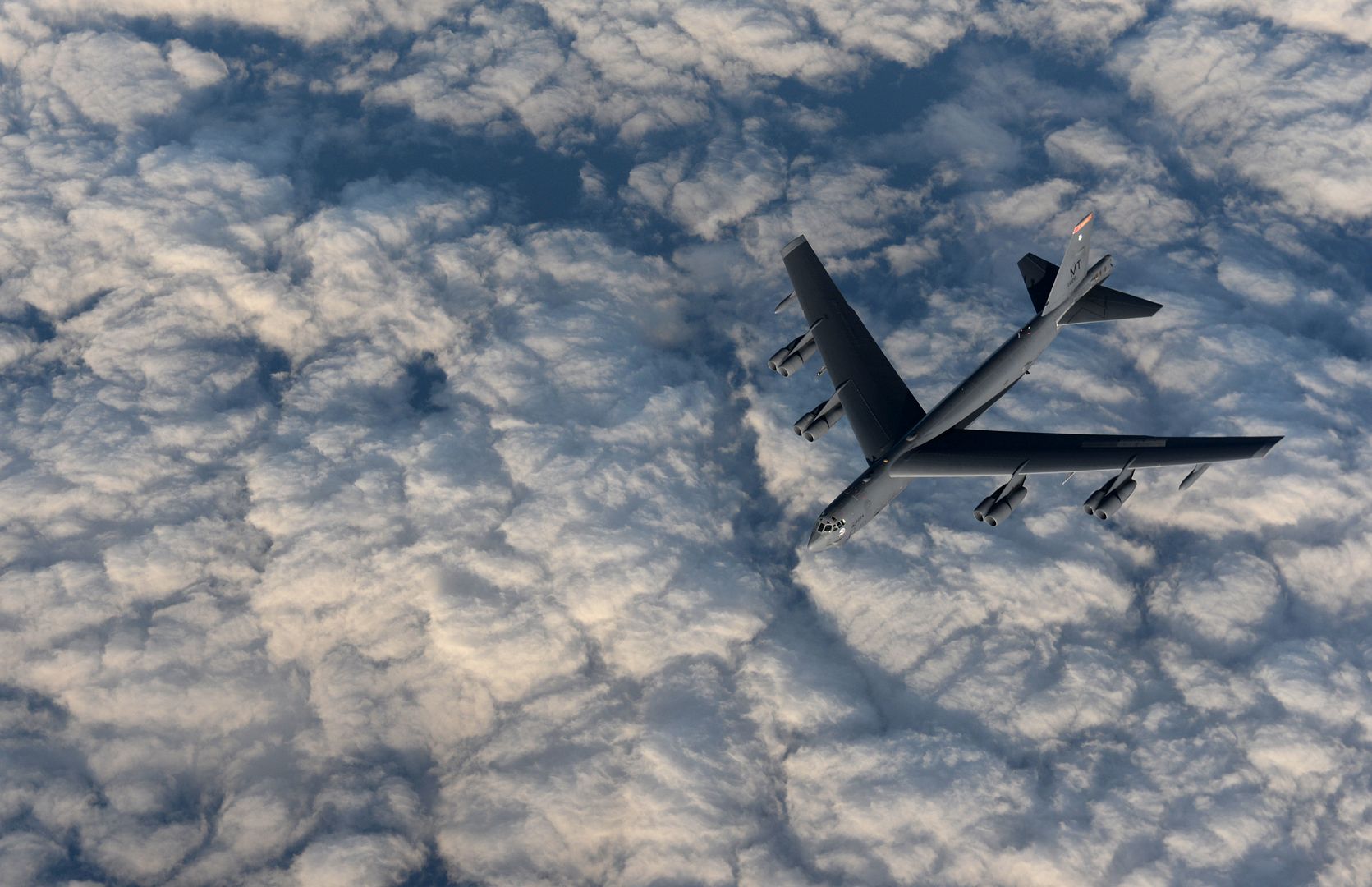
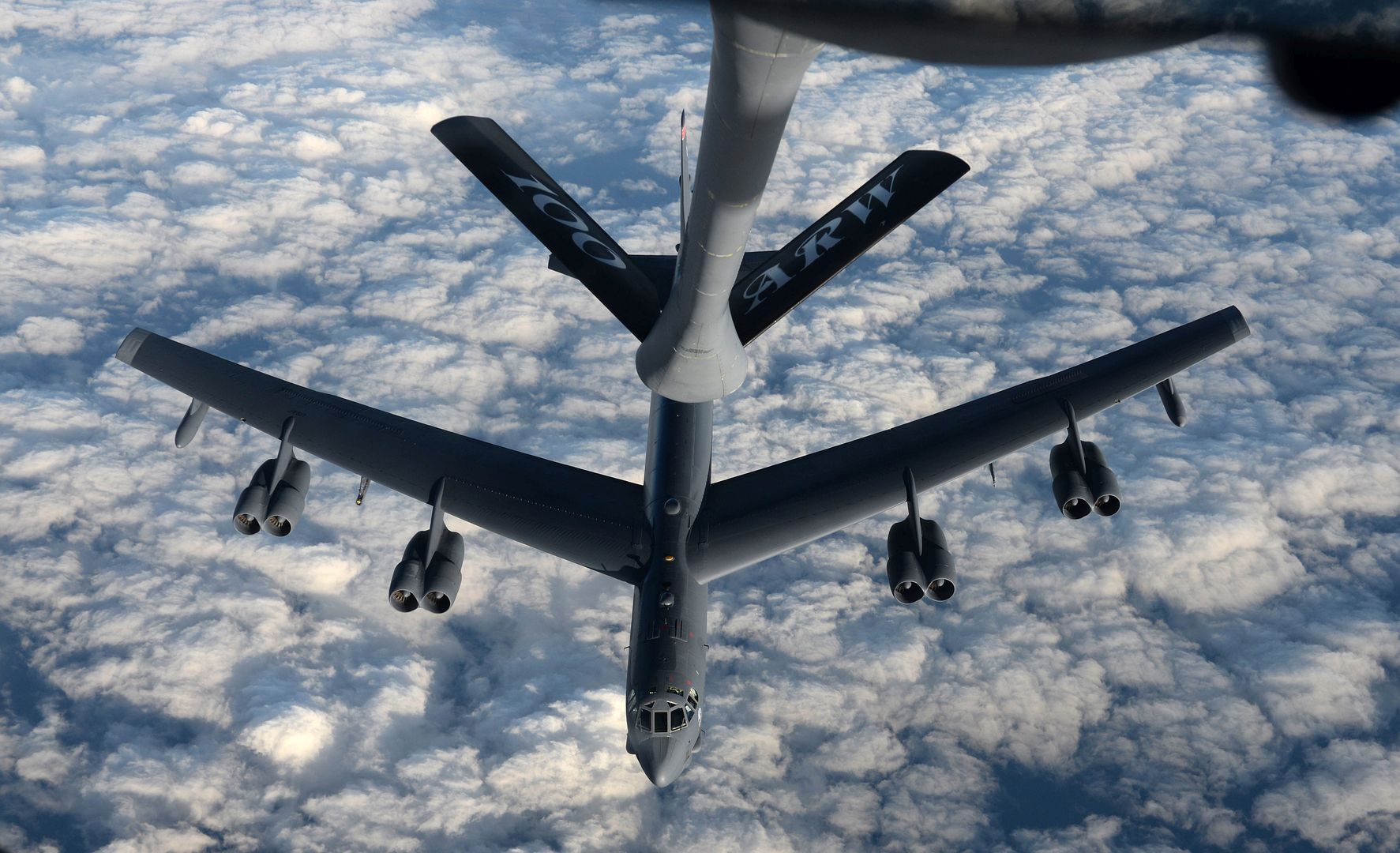
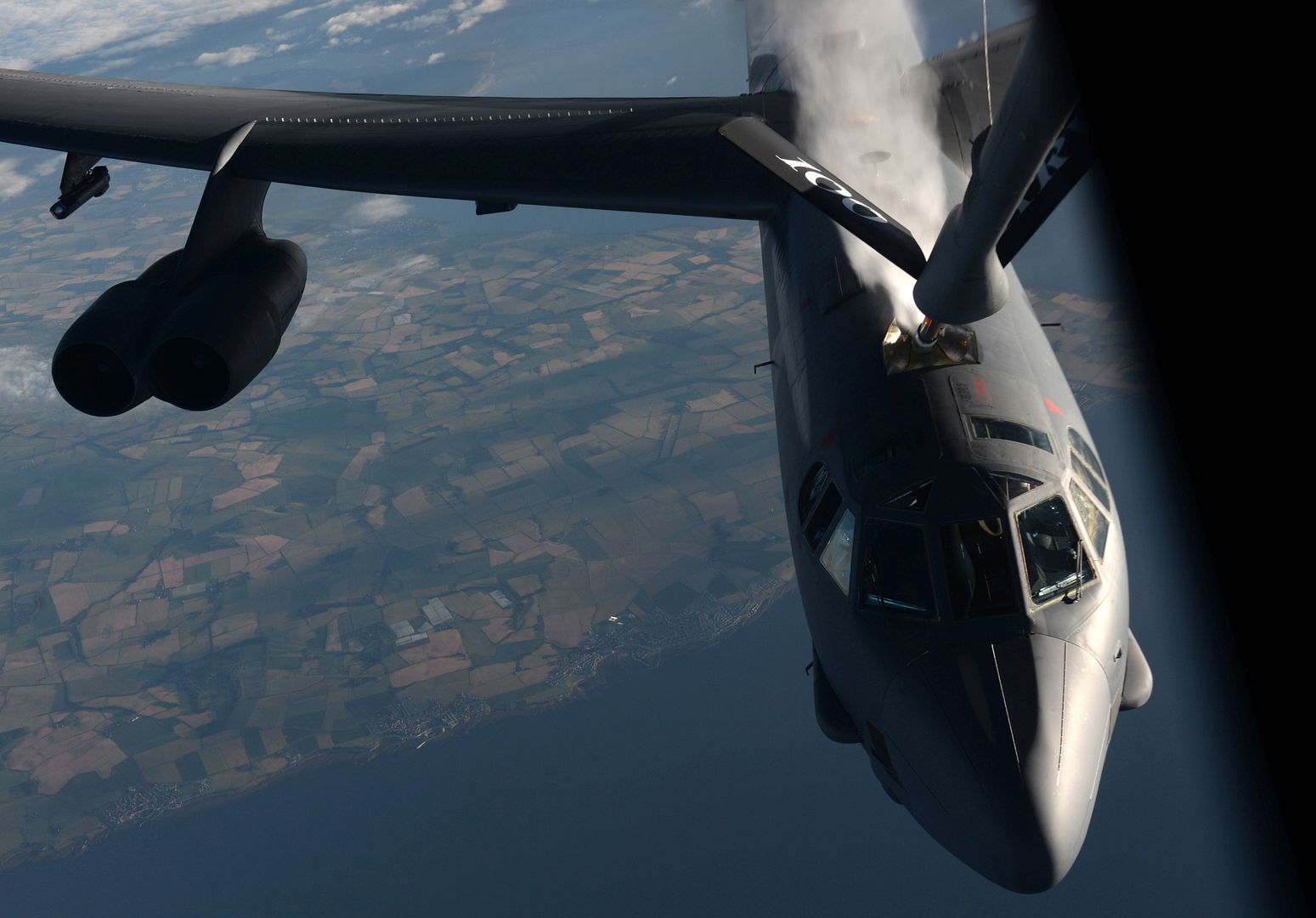
EDWARDS AIR FORCE BASE, Calif. --
The F-35 Lightning II advanced its combat capability by launching an air-to-air missile and directly hitting a drone over a military test range off the California coast July 28.
U.S. Air Force test pilot, Maj. Raven LeClair, employed an AIM-9X missile from an F-35A's external wing against an aerial drone target in restricted military sea test range airspace. Test data and observers confirmed the F-35 identified and targeted the drone with its mission systems sensors, passed the target 'track' information to the missile, enabled the pilot to verify targeting information using the high off-boresight capability of the helmet mounted display (HMD) and launched the AIM-9X from the aircraft to engage the target drone. After launch, the missile successfully acquired the target and followed an intercept flight profile before destroying the drone, achieving the first F-35 Air-to-Air kill or "Boola Boola," which is the traditional radio call made when a pilot shoots down a drone.
Immediately prior to launching the AIM-9X, LeClair employed an internally carried AIM-120C missile against another target drone. This target was beyond visual range and the AIM-120C was given a successful self-destruct signal right before target impact.
The AIM-9X is a short-range heat-seeking missile with an off-boresight capability for accuracy and features thrust-vectoring controls for increased turn capability. The F-35 can carry two AIM-9X missiles on its wings.
During previous test shots a self-destruct signal had been sent to the missile prior to it hitting the target.
"It's been said you don't really have a fighter until you can actually hit a target and we crossed that threshold with the first air-to-air weapon delivery of an AIM-9X. This successful test demonstrates the combat capability the F-35 will bring to the U.S. Military and our allies," said LeClair. "This test represents the culmination of many years of careful planning by combined government and contractor teams. We want to ensure operators will receive the combat capability they need to execute their mission and return home safely - we cannot compromise or falter in delivering this capability."
The missile test is part of a weapons delivery accuracy surge being conducted by the F-35 Joint Program Office Test Teams at Edwards Air Force Base, Point Mugu Sea Test Range, White Sands Missile Range and Naval Air Weapons Station China Lake. The focus of the increased weapons testing is to advance 3F software testing, which will provide full warfighting capabilities to the F-35. Other ordnance being released during surge testing include: Small Diameter Bombs, Joint Direct Attack Munitions and AIM-120s.
The F-35 is a multi-role, next-generation fighter that combines advanced stealth with speed, agility and a 360-degree view of the battlespace. The F-35 will form the backbone of air combat superiority for decades to come and replace legacy tactical fighter fleets with dominant air-to-air and air-to-ground capabilities to deter and defeat potential adversaries.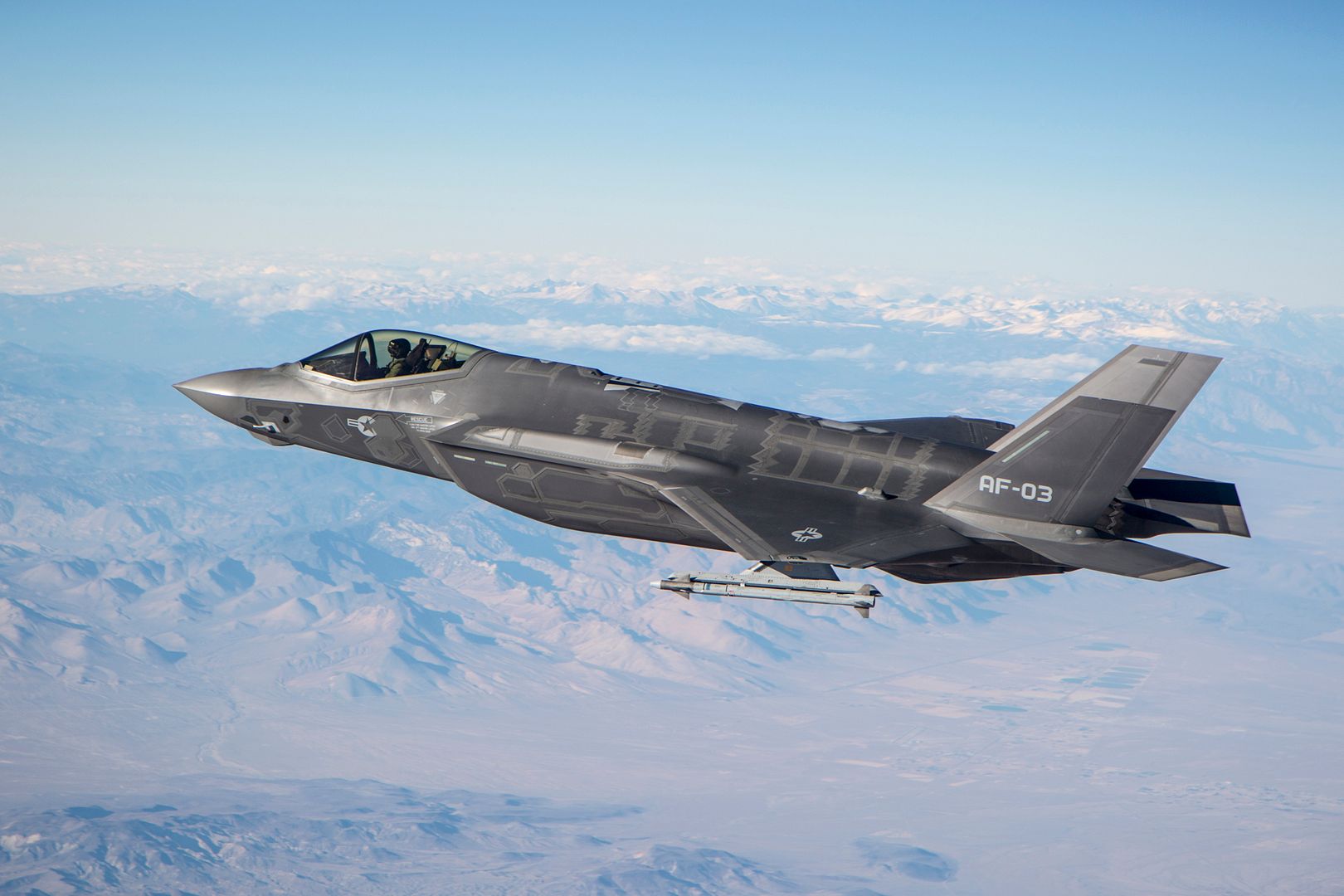
-
 Main AdminAn F-16, assigned to the 555th Fighter Squadron, Aviano Air Base, Italy, sits on the flightline at Nellis Air Force Base, Nev., Aug. 2, 2016, before participation in Green Flag 16-8. Green Flag-West, a realistic air-land integration combat training exercise involving the air forces of the United States and its allies, is primarily conducted in conjunction with U.S. Army Combat Training Center exercises at Ft. Irwin, Calif. (United States Air Force photo by Airman 1st Class Kevin Tanenbaum/Released)
Main AdminAn F-16, assigned to the 555th Fighter Squadron, Aviano Air Base, Italy, sits on the flightline at Nellis Air Force Base, Nev., Aug. 2, 2016, before participation in Green Flag 16-8. Green Flag-West, a realistic air-land integration combat training exercise involving the air forces of the United States and its allies, is primarily conducted in conjunction with U.S. Army Combat Training Center exercises at Ft. Irwin, Calif. (United States Air Force photo by Airman 1st Class Kevin Tanenbaum/Released)
An F-16, assigned to the 555th Fighter Squadron, Aviano Air Base, Italy, accelerates down the runway during take-off at Nellis Air Force Base, Nev., August 2, 2016, before participation in Green Flag 16-8. Green Flag exercises provide critical joint training for approximately 75,000 joint and coalition personnel per year, including 3,000 sorties, 6,000 flight hours, and the expenditure of over 700,000 pounds of live and training ordnance. (United States Air Force photo by Airman 1st Class Kevin Tanenbaum/Released)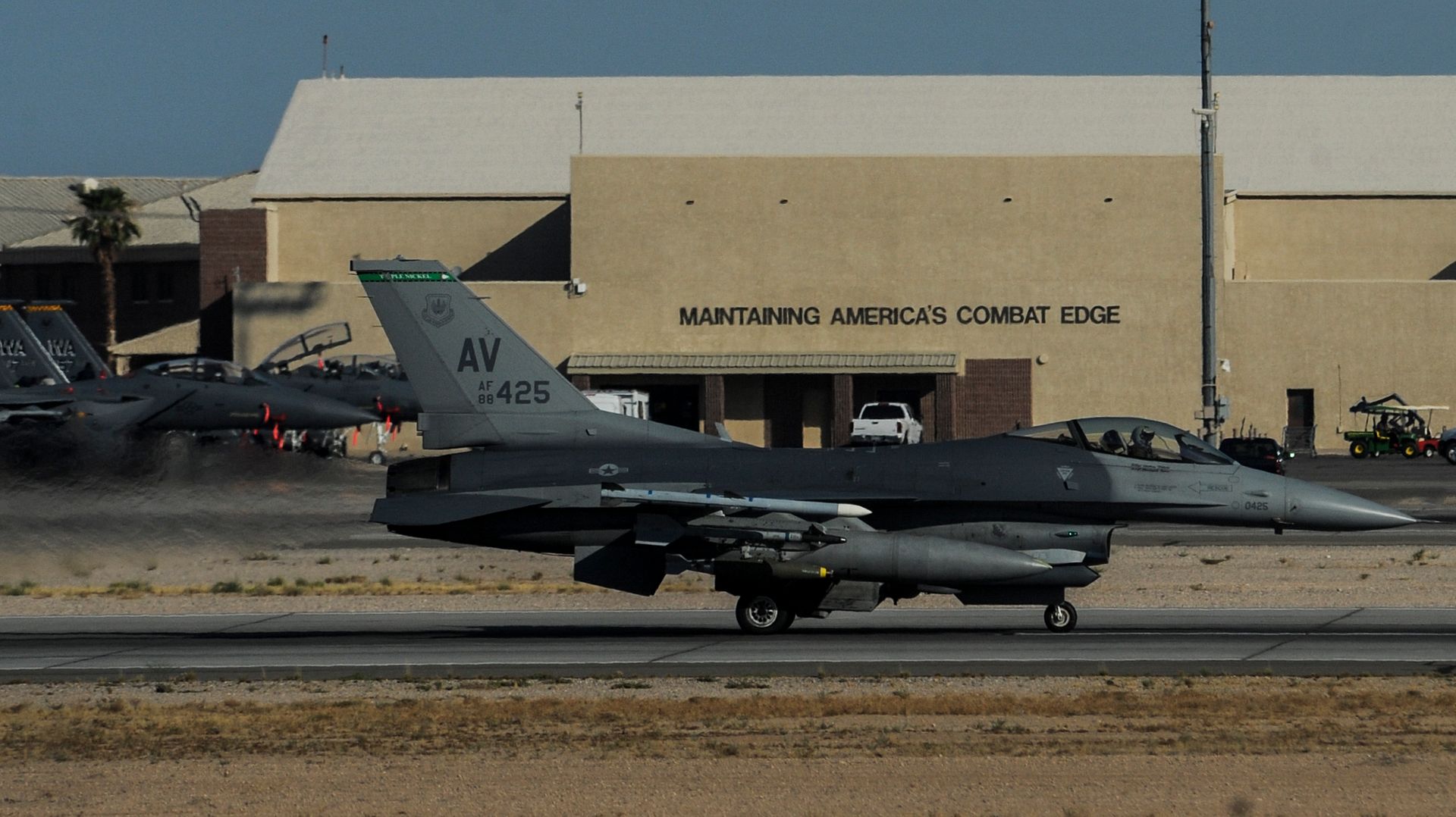
-
 Main AdminAn F-35A taxis down the flight line Aug. 2, 2016, at Eglin Air Force Base, Fla. The 33rd Fighter Wing performed a sortie surge Aug. 1-3 completing more than three times the normal number of weekly sorties. (U.S. Air Force photo by Senior Airman Stormy Archer)
Main AdminAn F-35A taxis down the flight line Aug. 2, 2016, at Eglin Air Force Base, Fla. The 33rd Fighter Wing performed a sortie surge Aug. 1-3 completing more than three times the normal number of weekly sorties. (U.S. Air Force photo by Senior Airman Stormy Archer)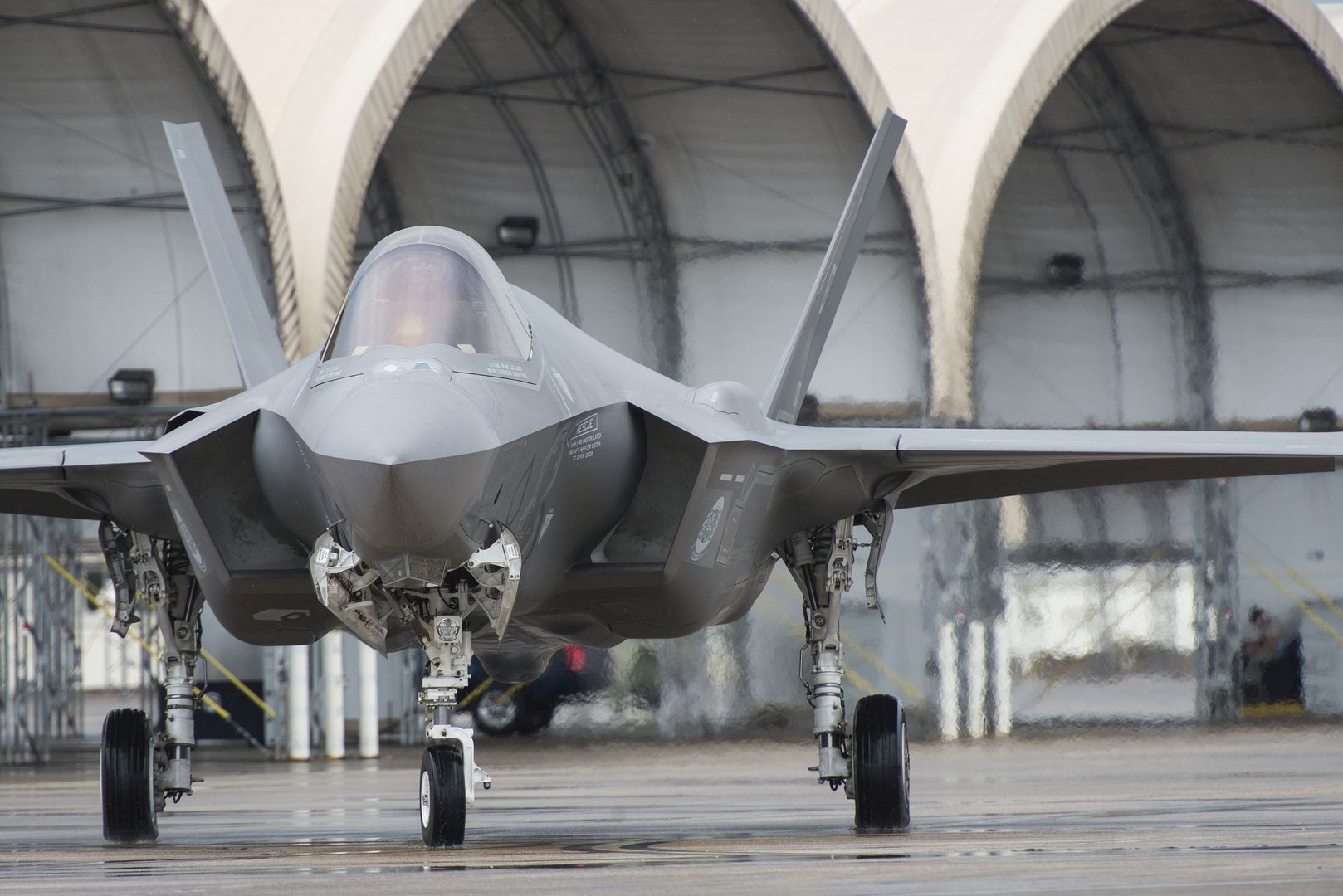
A Coast Guard aircrew aboard an MH-65 Dolphin helicopter, from Air Station Port Angeles, Wash., performs a search and rescue demonstration on the Seattle waterfront during the Seafair Fleet Week, August 3, 2016. Now in it?s 67th year, Seafair is an annual Seattle event that celebrates summer in the Pacific Northwest.
U.S. Coast Guard photo by Petty Officer 1st Class Zac Crawford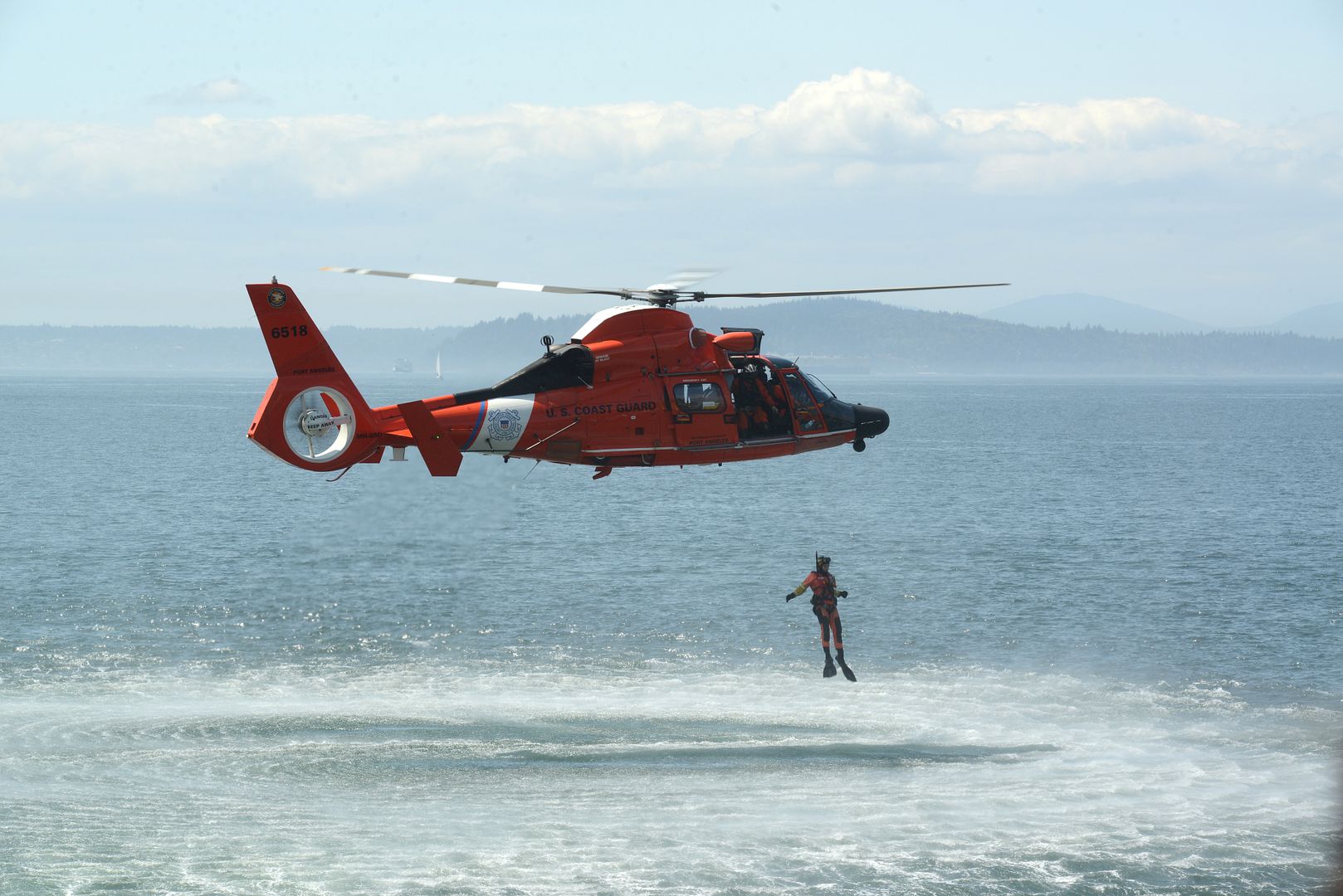
An AH-64D Apache Longbow attack helicopter, assigned to the 1st Battalion (Attack), 3rd Aviation Regiment, 12th Combat Aviation Brigade, initiates its first itinerary during an aerial gunnery at the 7th Army Training Command's Grafenwoehr Training Area, Germany, Aug. 3, 2016. (U.S. Army photo by Christoph Koppers)
-
 Main AdminMesserschmitt Bf109 G-12 First Take Off
Main AdminMesserschmitt Bf109 G-12 First Take Off

-
 Main AdminAn F-16 from the United States Air Force sit on the tarmac at RAAF Base Darwin during Exercise Pitch Black 16. Pitch Black is a biennial multinational air warfare exercise hosted by the Royal Australian Air Force (RAAF) that focuses on offensive counter air and defensive counter air combat in a simulated war environment. (Australian Defence Force photo by Cpl. David Gibbs)
Main AdminAn F-16 from the United States Air Force sit on the tarmac at RAAF Base Darwin during Exercise Pitch Black 16. Pitch Black is a biennial multinational air warfare exercise hosted by the Royal Australian Air Force (RAAF) that focuses on offensive counter air and defensive counter air combat in a simulated war environment. (Australian Defence Force photo by Cpl. David Gibbs)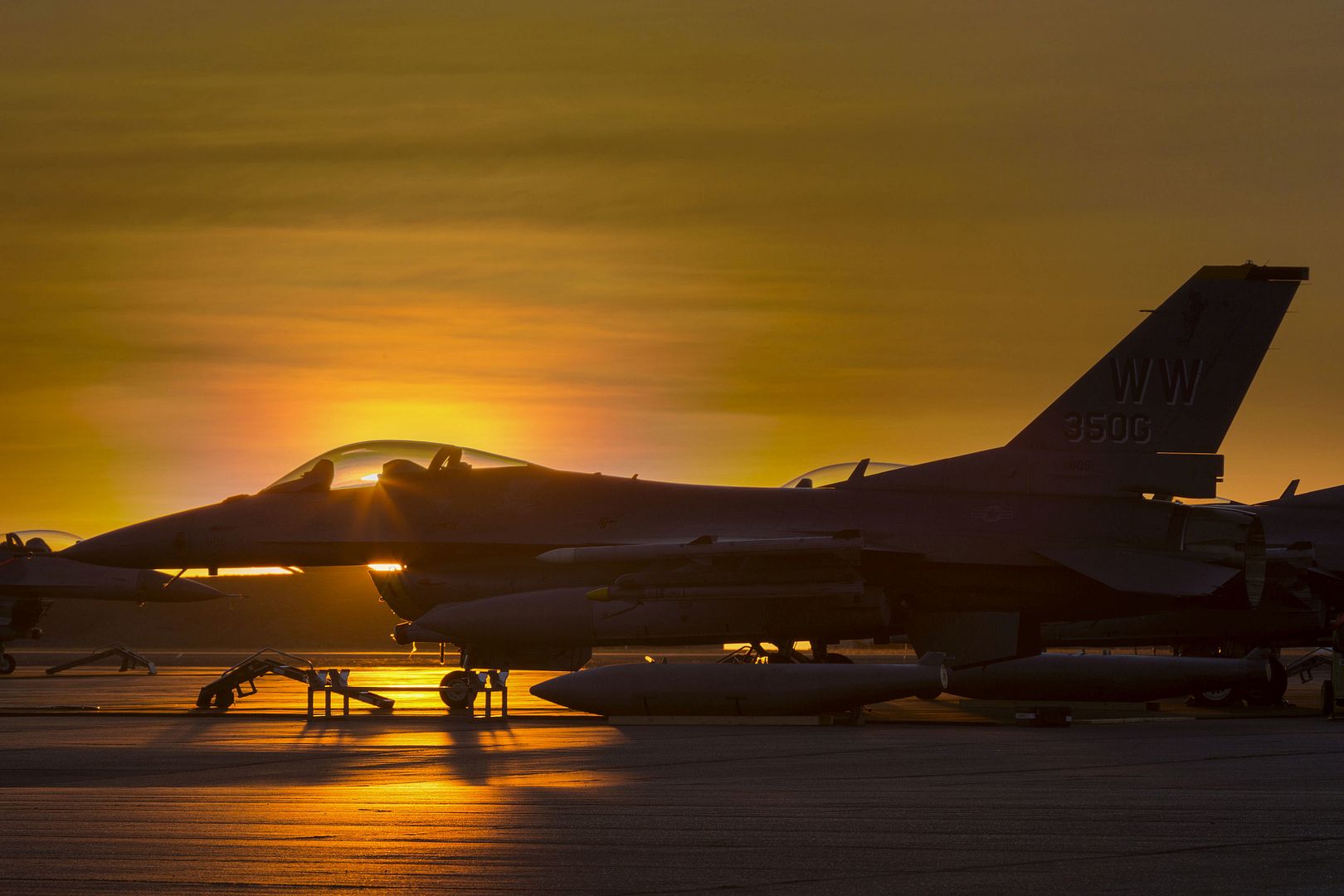
A line up of F-16s from the United States Air Force sit on the tarmac at RAAF Base Darwin during Exercise Pitch Black 16. Pitch Black is a biennial multinational air warfare exercise hosted by the Royal Australian Air Force (RAAF) that focuses on offensive counter air and defensive counter air combat in a simulated war environment. (Australian Defence Force photo by Cpl. David Gibbs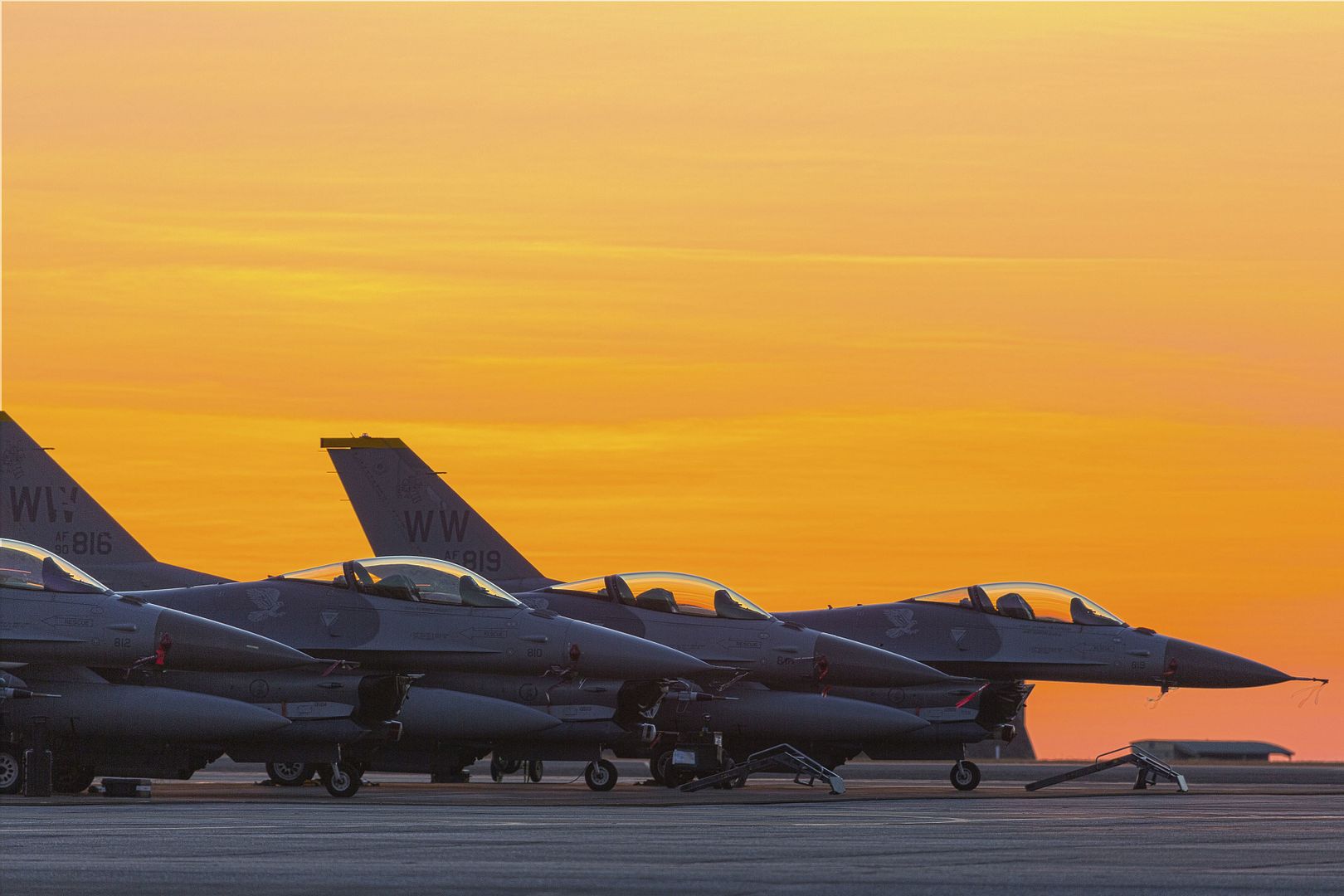
An F-16 from the United States Air Force takes off from RAAF Base Darwin, during Exercise Pitch Black 16. Pitch Black is a biennial multinational air warfare exercise hosted by the Royal Australian Air Force (RAAF) that focuses on offensive counter air and defensive counter air combat in a simulated war environment. (Australian Defence Force photo by Cpl. David Gibbs)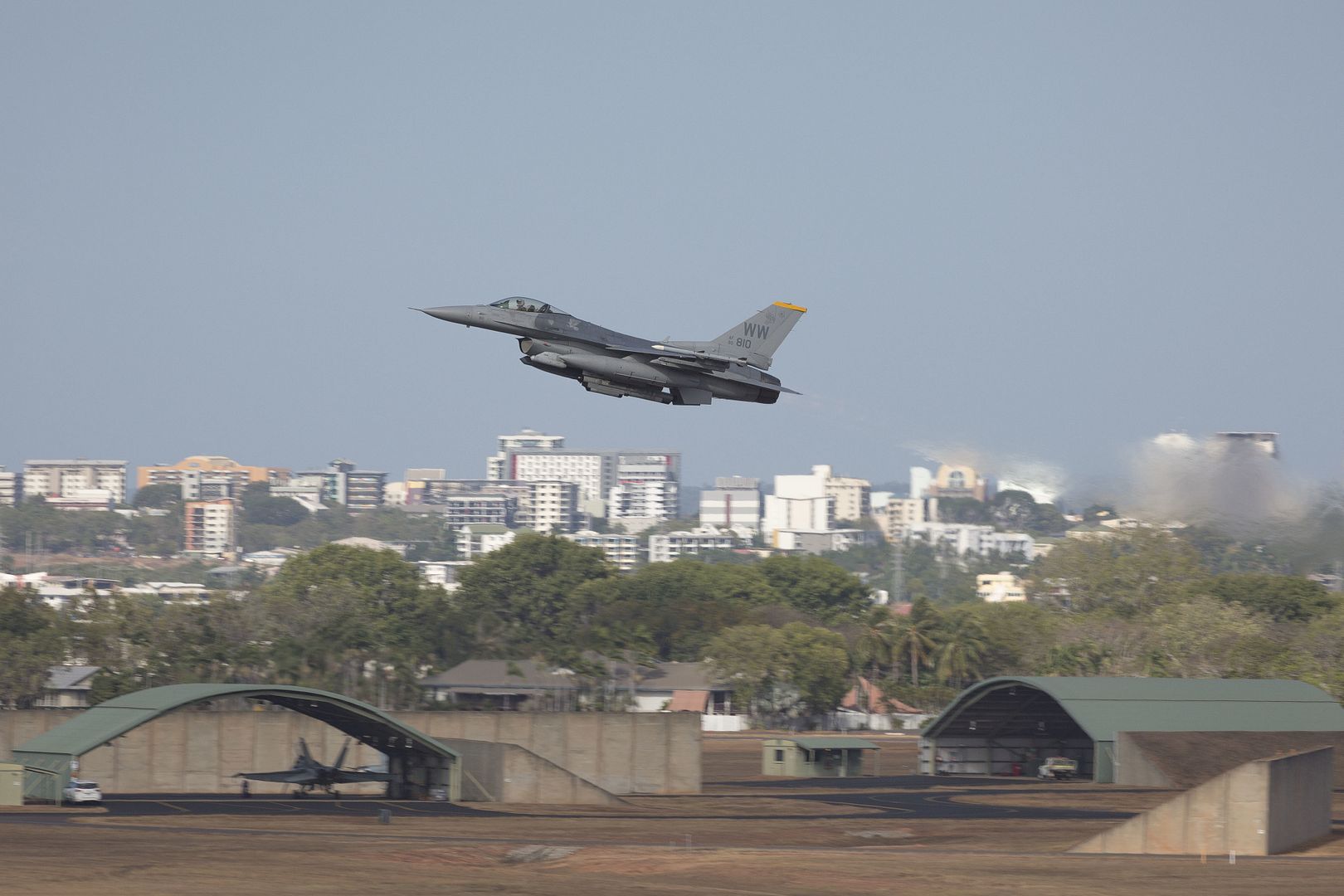
U.S. Air Force F-15E Strike Eagles dual-role fighter aircraft assigned to the 336th Fighter Squadron, Seymour Johnson Air Force Base, N.C., taxi for take off Aug. 5, 2016, at Eielson Air Force Base, Alaska, during familiarization day of RED FLAG-Alaska 16-3. This exercise provides unique opportunities to integrate various forces into joint, coalition and multilateral training from simulated forward operating bases. (U.S. Air Force photo by Staff Sgt. Shawn Nickel)
A U.S. Air Force F-15E Strike Eagle dual-role fighter aircraft assigned to the 336th Fighter Squadron, Seymour Johnson Air Force Base, N.C., prepares to take off Aug. 5, 2016, from Eielson Air Force Base, Alaska, during familiarization day of RED FLAG-Alaska (RF-A) 16-3. Originally operated under the name COPE THUNDER, the exercise moved to Eielson in 1992 from Clark Air Base, Philippines, after the eruption of Mount Pinatubo on June 15, 1991. COPE THUNDER was re-designated RF-A in 2006. (U.S. Air Force photo by Staff Sgt. Shawn Nickel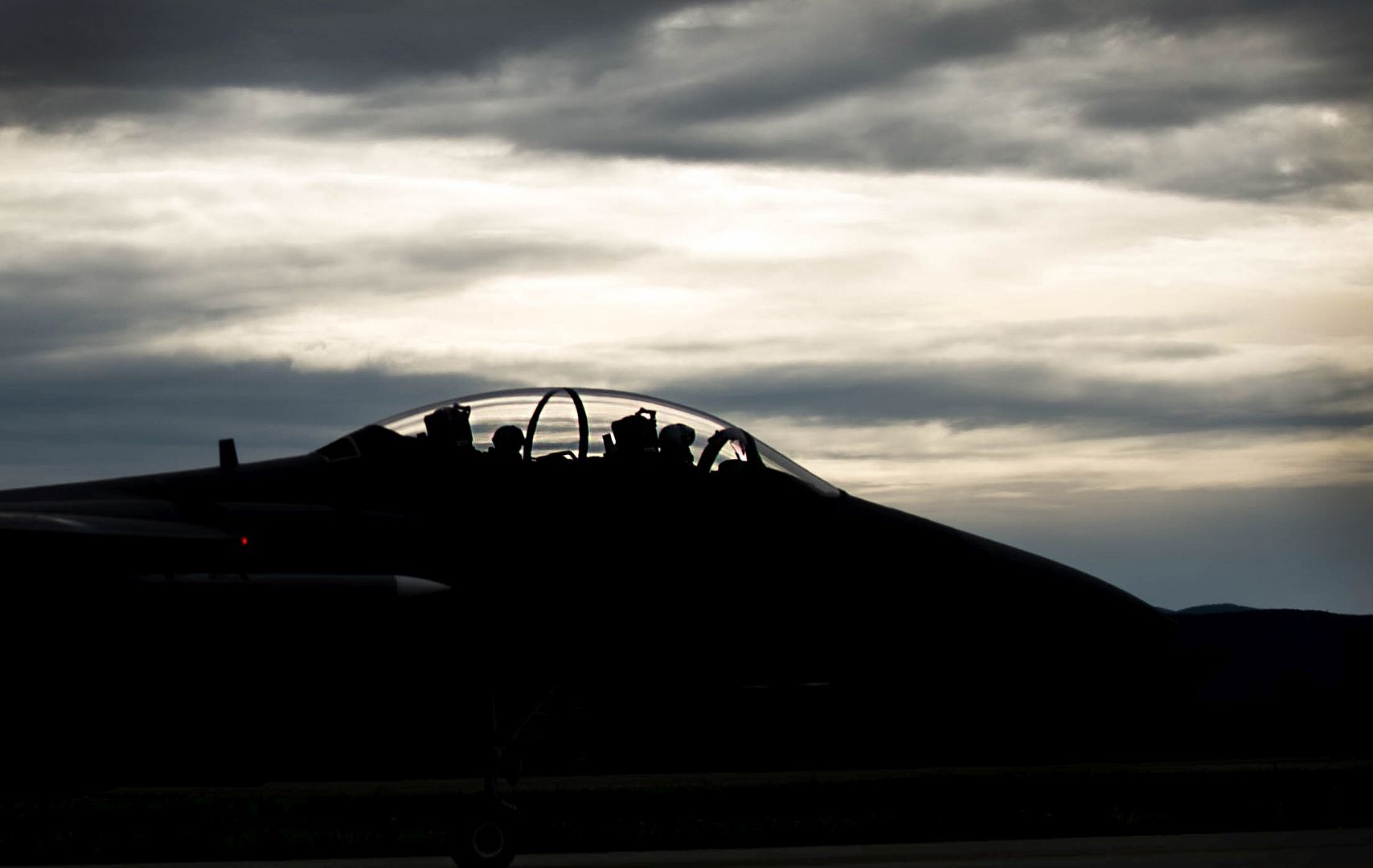
A U.S. Air Force F-15E Strike Eagle dual-role fighter aircraft assigned to the 336th Fighter Squadron, Seymour Johnson Air Force Base, N.C., takes off Aug. 5, 2016, at Eielson Air Force Base, Alaska, during a familiarization flight for RED FLAG-Alaska (RF-A) 16-3. RF-A provides training for deployed maintenance and support personnel in sustainment of large-force deployed air operations. (U.S. Air Force photo by Staff Sgt. Shawn Nickel)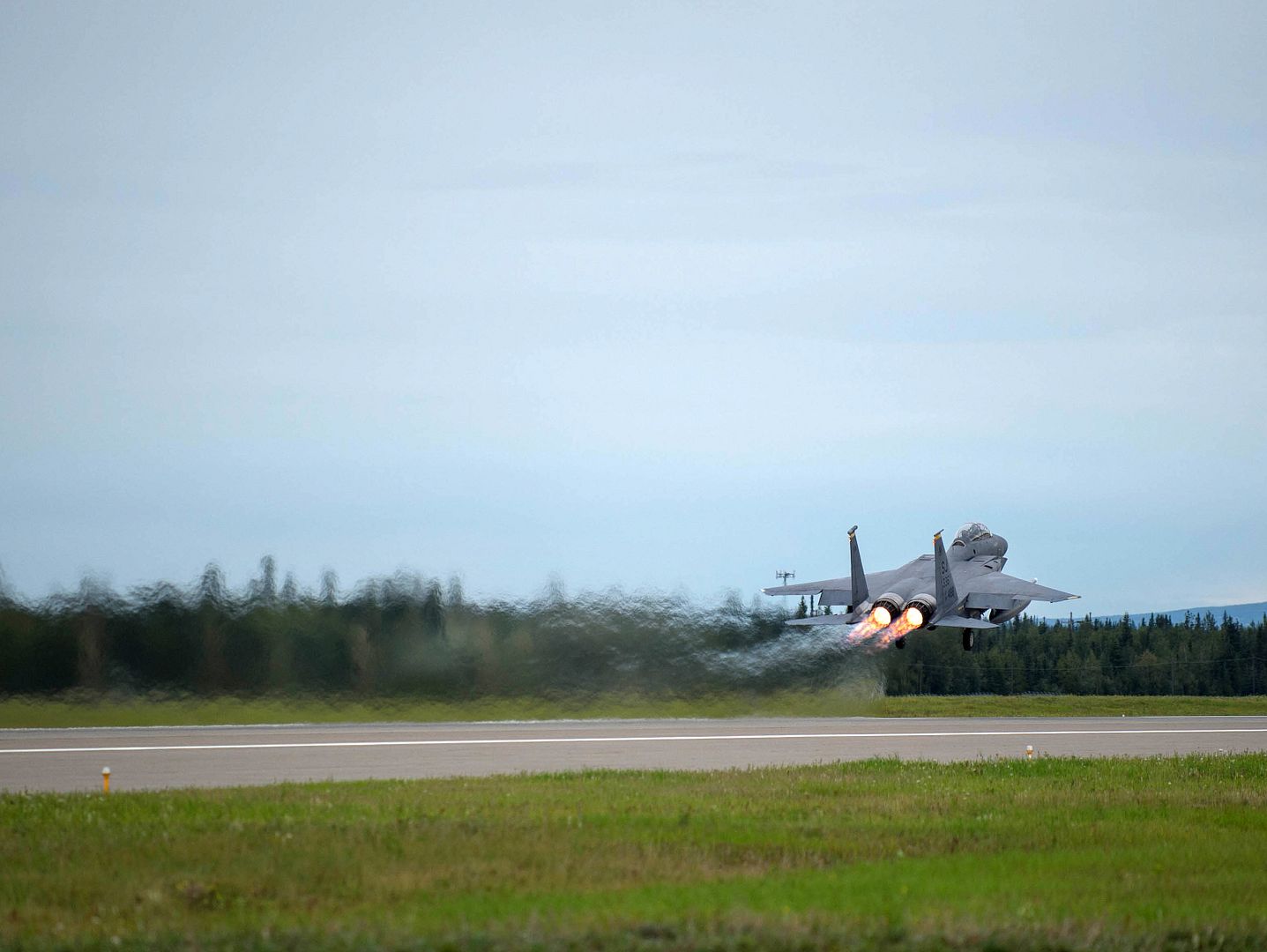
SEATTLE, Wash. (Aug. 5, 2016) ? The U.S. Navy Flight Demonstration Squadron, the Blue Angels, fly in formation during a practice show Seattle's 67th annual Seafair Fleet Week. Seafair Fleet Week is an annual celebration of the sea services wherein Sailors, Marines and Coast Guardsmen from visiting U.S. Navy and Coast Guard ships and ships from Canada make the city a port of call. (U.S. Navy photo by Mass Communication Specialist 1st Class Cory Asato/Released)
An F-22 Raptor from the 43rd Fighter Squadron, performs a vertical takeoff during Sentry Savannah 16-3 in Savannah, Ga., Aug. 2, 2016. The F-22 is a key component of air dominance, and during Sentry Savannah, they contributed to a variety of missions, such as escort and defensive counter-air missions, among others. (U.S. Air Force photo by Senior Airman Solomon Cook/Released)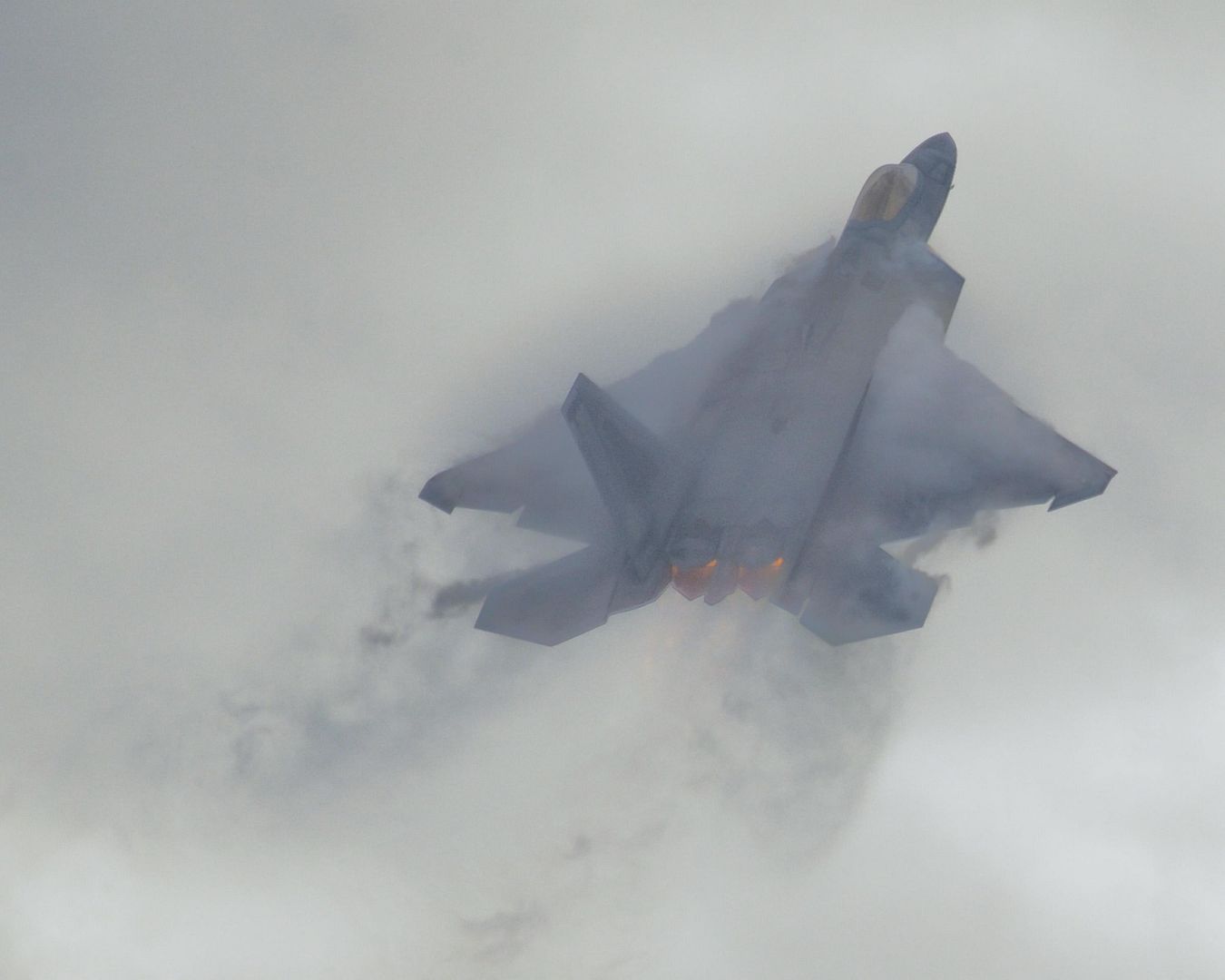
A T-38 Talon from the 2nd Fighter Training Squadron, accelerates down the flightline during Sentry Savannah 16-3 in Savannah, Ga., Aug. 2, 2016. Sentry Savannah is an exercise that gives a unique opportunity to conduct training missions with multiple unique types of aircraft called dissimilar air combat training. (U.S. Air Force photo by Senior Airman Solomon Cook/Released)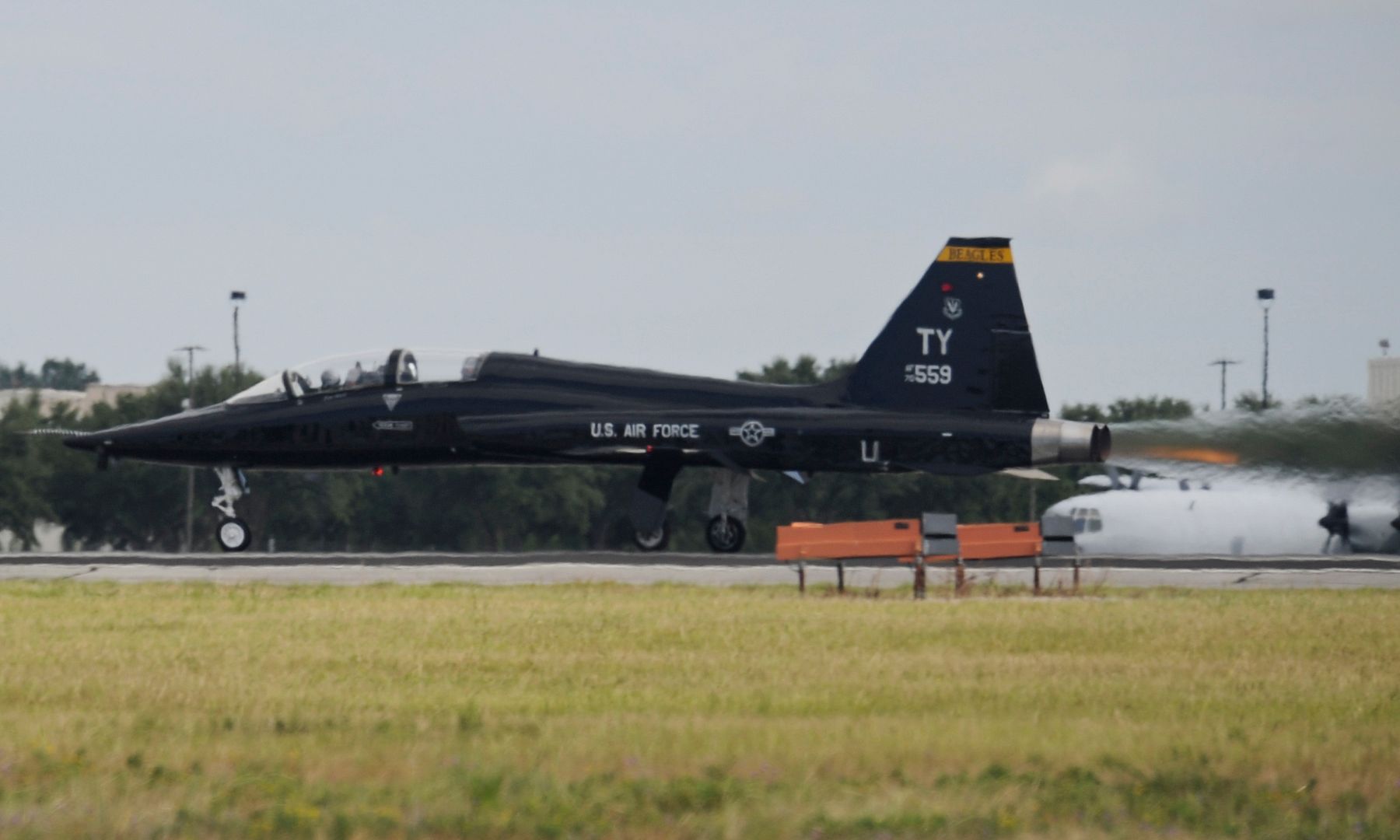
-
 Main AdminA B-1B Lancer assigned to the 34th Expeditionary Bomb Squadron, deployed from Ellsworth Air Force Base, S.D., lands on the flightline Aug. 6, 2016, at Andersen AFB, Guam. The B-1 is deploying to Andersen Air Force Base for the first time in 10 years to support the U.S. Pacific Command?s Continuous Bomber Presence mission.(U.S. Air Force photo's/Airman 1st Class Arielle Vasquez)
Main AdminA B-1B Lancer assigned to the 34th Expeditionary Bomb Squadron, deployed from Ellsworth Air Force Base, S.D., lands on the flightline Aug. 6, 2016, at Andersen AFB, Guam. The B-1 is deploying to Andersen Air Force Base for the first time in 10 years to support the U.S. Pacific Command?s Continuous Bomber Presence mission.(U.S. Air Force photo's/Airman 1st Class Arielle Vasquez)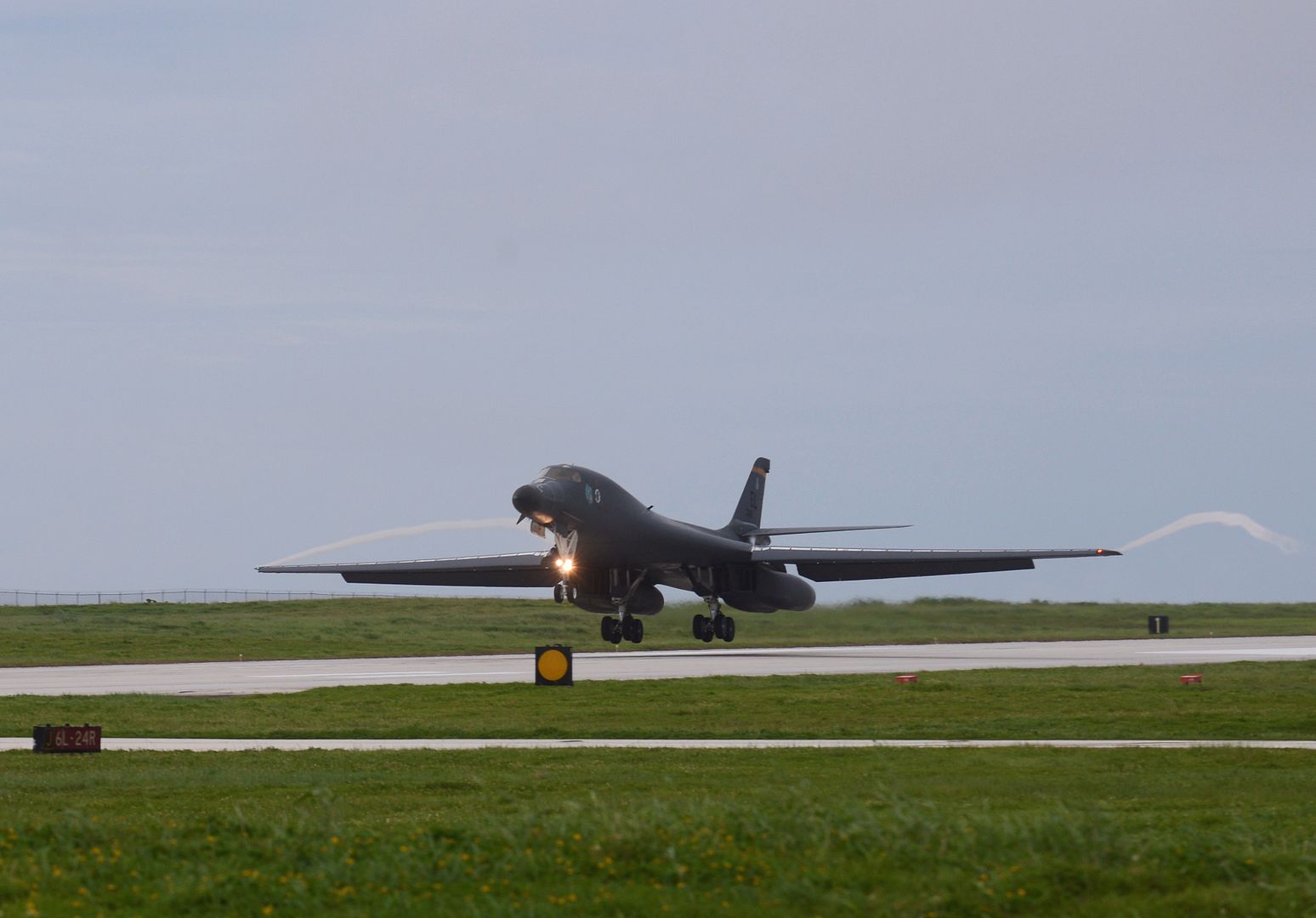
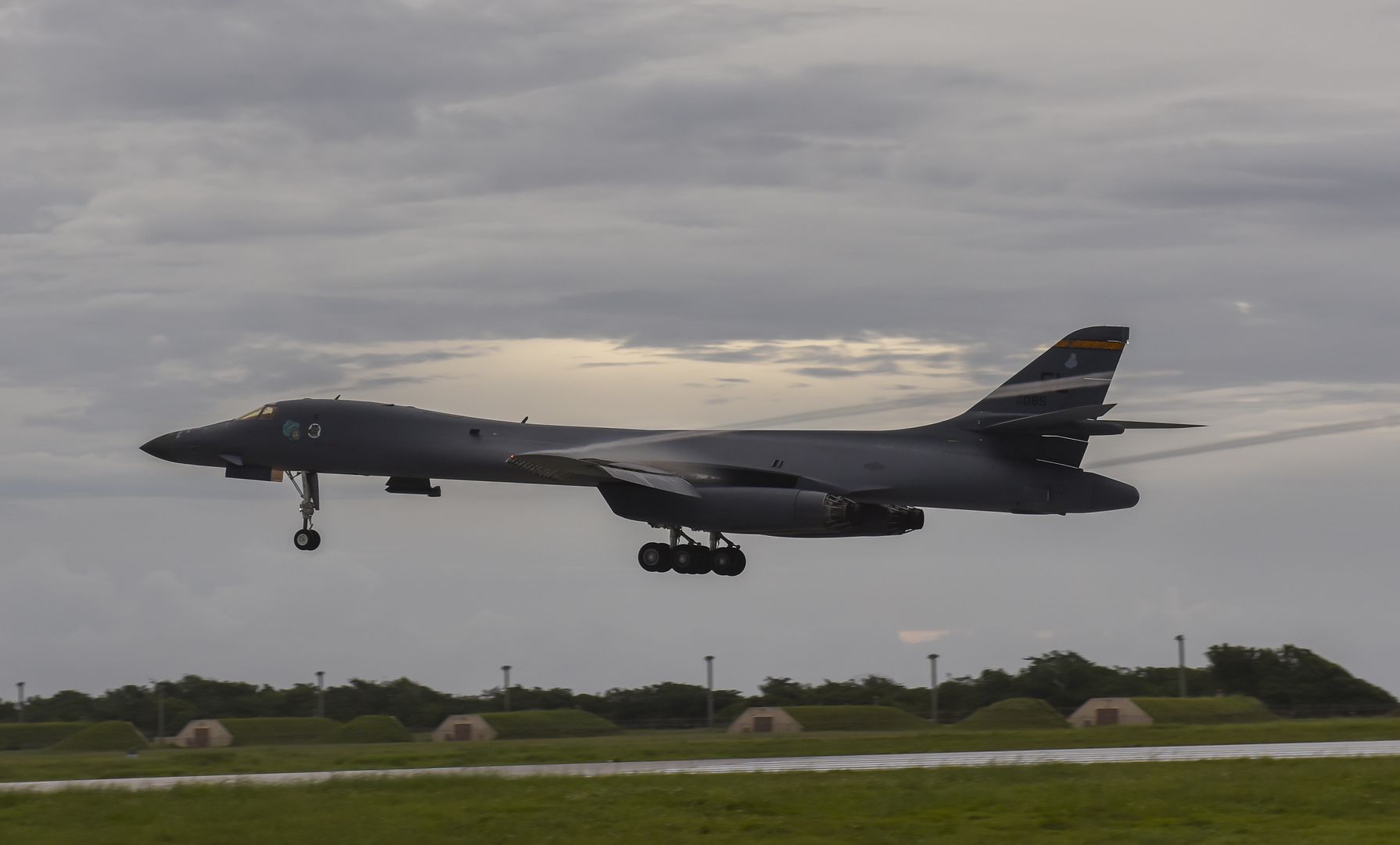
Aircrew members assigned to the 34th Expeditionary Bomb Squadron, deployed from Ellsworth Air Force Base, S.D., conduct post flight checks Aug. 6, 2016, at Andersen Air Force Base, Guam. The 34th EBS members are supporting the U.S. Pacific Command?s Continuous Bomber Presence operations. (U.S. Air Force photo by Master Sgt. JT May III/Released)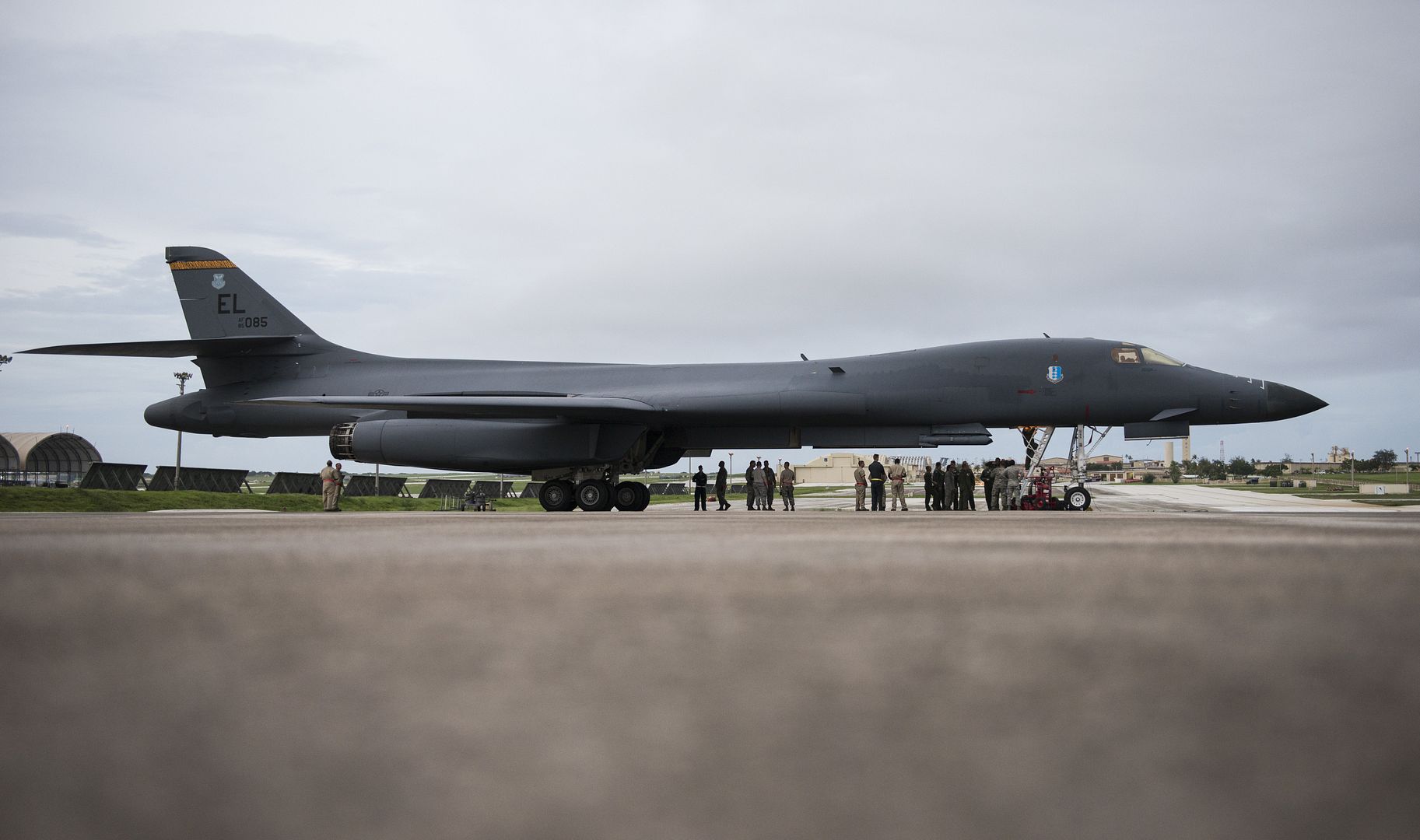
MEDITERRANEAN SEA (Aug. 1, 2016) An AV-8B Harrier II with 22nd Marine Expeditionary Unit (MEU), launches from the flight deck of the amphibious assault ship USS Wasp (LHD 1) Aug. 1, 2016. 22nd MEU, embarked on the Wasp is conducting precision air strikes in support of the Libyan Government of National Accord-aligned forces against Daesh targets in Sirte, Libya as part of Operation Odyssey Lightning. (U.S. Marine Corps photo by Lance Cpl. Koby I. Saunders)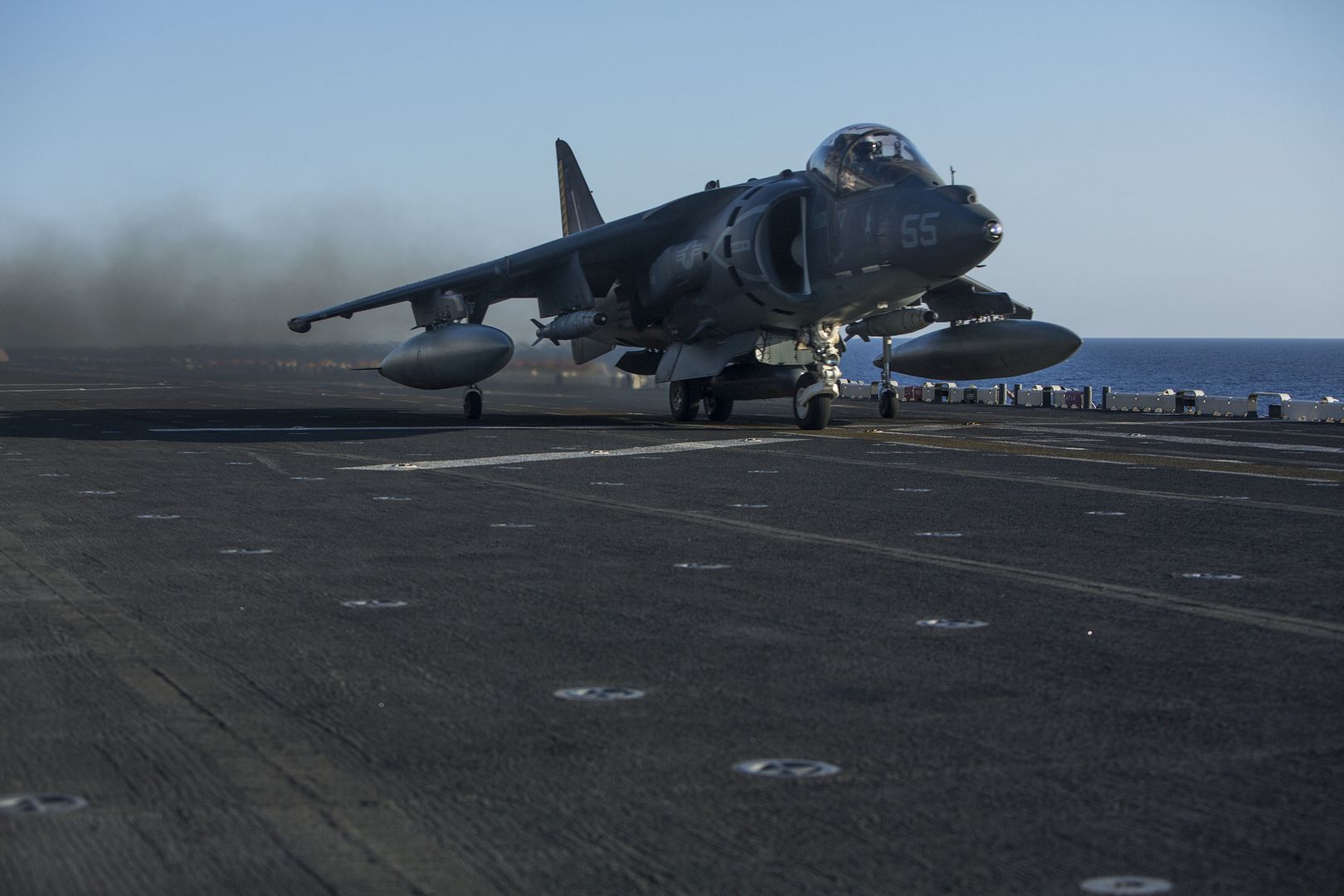
Indonesian Air Force ground maintenance personnel prepare an F-16 for another sortie, during Exercise Pitch Black 16.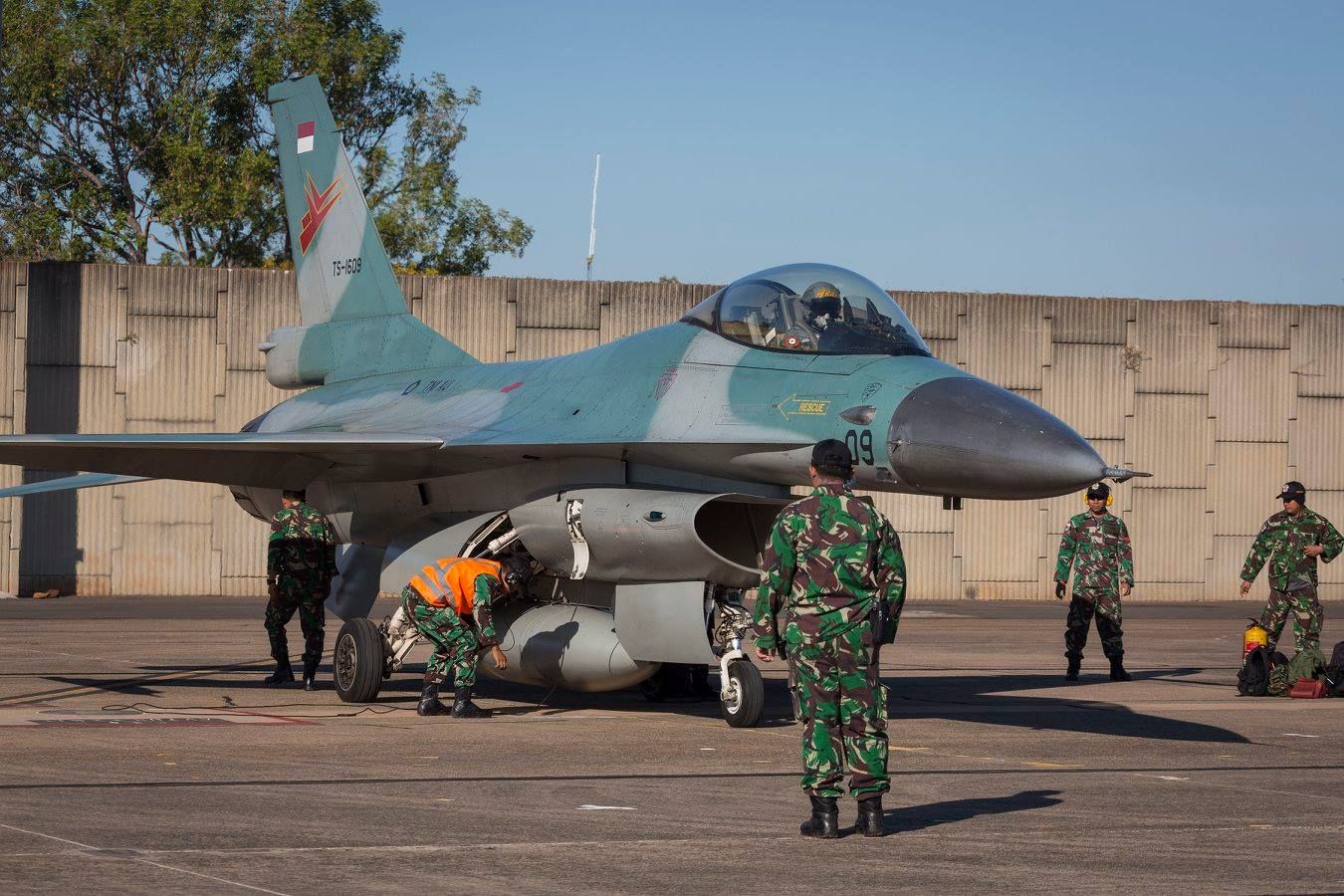
An F-16 from the Indonesian Air Force taxis out for another sortie, during Exercise Pitch Black 16.
-
 Main AdminATSUGI, Japan (Aug. 4, 2016) An E-2C Hawkeye from (VAW) 115, an F/A-18E Super Hornets from (VFA) 195, an F-4EJ Phantom II fighter from 302nd Tactical Fighter Squadron, Japan Air Self Defense Force, fly in formation as part of the second annual Benkyoukai training event between the Japan Air Self Defense Force (JASDF) and Carrier Air Wing Five (CVW 5). The week-long event, led by the ?Dambusters? of Strike Fighter Squadron (VFA) 195, incorporated Dissimilar Air Combat Training (DACT) with the Japanese 302nd Tactical Fighter Squadron (TFS). (U.S. Navy photo by Cmdr. Guy Snodgrass/Released)
Main AdminATSUGI, Japan (Aug. 4, 2016) An E-2C Hawkeye from (VAW) 115, an F/A-18E Super Hornets from (VFA) 195, an F-4EJ Phantom II fighter from 302nd Tactical Fighter Squadron, Japan Air Self Defense Force, fly in formation as part of the second annual Benkyoukai training event between the Japan Air Self Defense Force (JASDF) and Carrier Air Wing Five (CVW 5). The week-long event, led by the ?Dambusters? of Strike Fighter Squadron (VFA) 195, incorporated Dissimilar Air Combat Training (DACT) with the Japanese 302nd Tactical Fighter Squadron (TFS). (U.S. Navy photo by Cmdr. Guy Snodgrass/Released)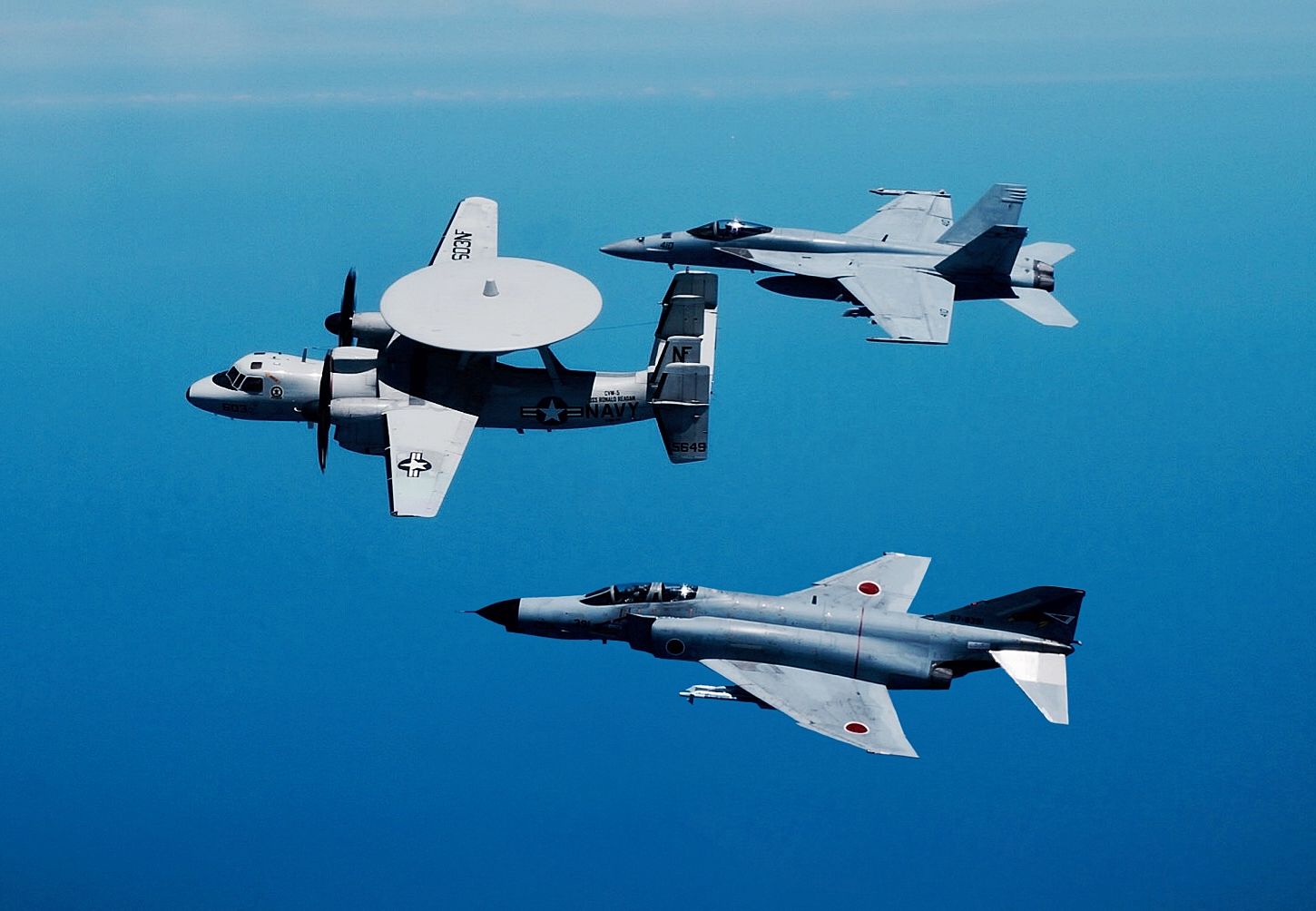
Airmen, attending the 57th Adversary Tactics Group change of command ceremony, take the first look at the new F-16 Fighting Falcon, assigned to the 64th Aggressor Squadron, paint scheme in the U.S. Air Force Thunderbird hangar at Nellis Air Force Base, Nev., Aug. 5, 2016. This one of the kind ?splinter? scheme is one of two different paint schemes that will be introduced in the coming months. (U.S. Air Force photo by Airman 1st Class Kevin Tanenbaum/Released)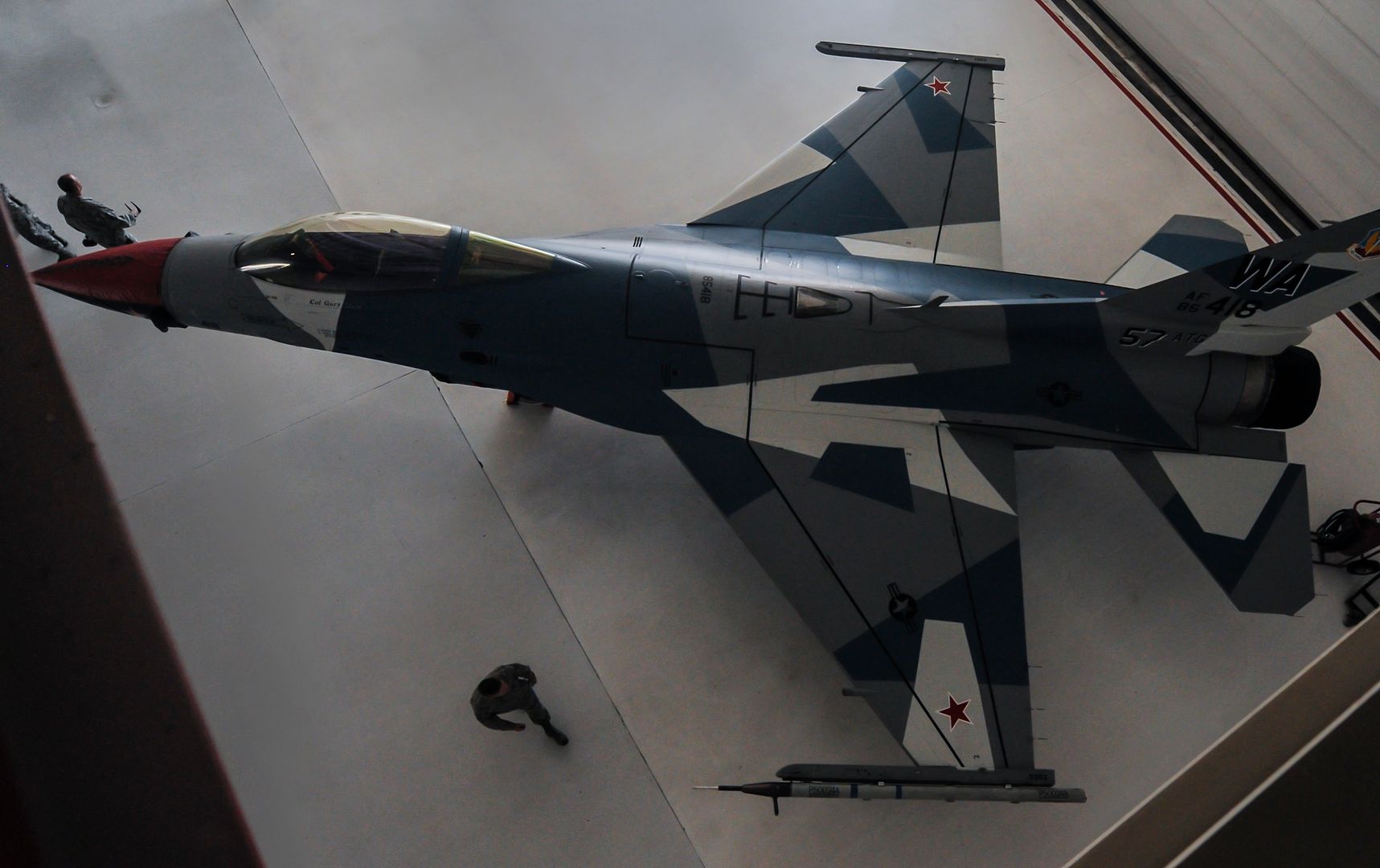
NOUAKCHOTT, Mauritania, Aug.8, 2016 ? Boeing (NYSE:BA) and Mauritania Airlines have finalized an order for one Next-Generation 737-800 airplane, valued at $96 million at current list prices.
?The Boeing 737 is the backbone of Mauritania Airlines fleet because of its efficiency and superior operating economics,? said Mohamed Radhy Bennahi, chief executive officer of Mauritania Airlines. ?The addition of this new 737-800 will greatly expand our network and enhance the overall travel experience of our passengers.?
The 737-800 is one of the best-selling versions of the highly successful Next-Generation 737 family, the most technologically advanced single-aisle airplane family. Mauritania Airlines? new 737 will feature the Boeing Sky Interior, the 787 Dreamliner inspired cabin. On board, passengers will enjoy a greater sense of spaciousness with decorative sculpted sidewalls, larger window reveals, LED mood lighting and larger pivot overhead stowage bins.
?Mauritania Airlines has been an important player in West African aviation for several years,? said Van Rex Gallard, vice president of Sales for Africa, Latin America and the Caribbean, Boeing Commercial Airplanes. ?Today?s order for one additional 737-800 underlines Mauritania Airlines? position as a leading carrier committed to providing its passengers with a growing choice of destinations and exceptional in-flight comfort.?
Based in Mauritania?s capital city Nouakchott, at Nouakchott-Oumtounsy International Airport, Mauritania Airlines was founded in 2010 and currently serves more than 10 destinations across Africa and Europe. The Mauritanian flag-carrier currently operates a fleet which includes one Next-Generation 737-700 and two 737-500s.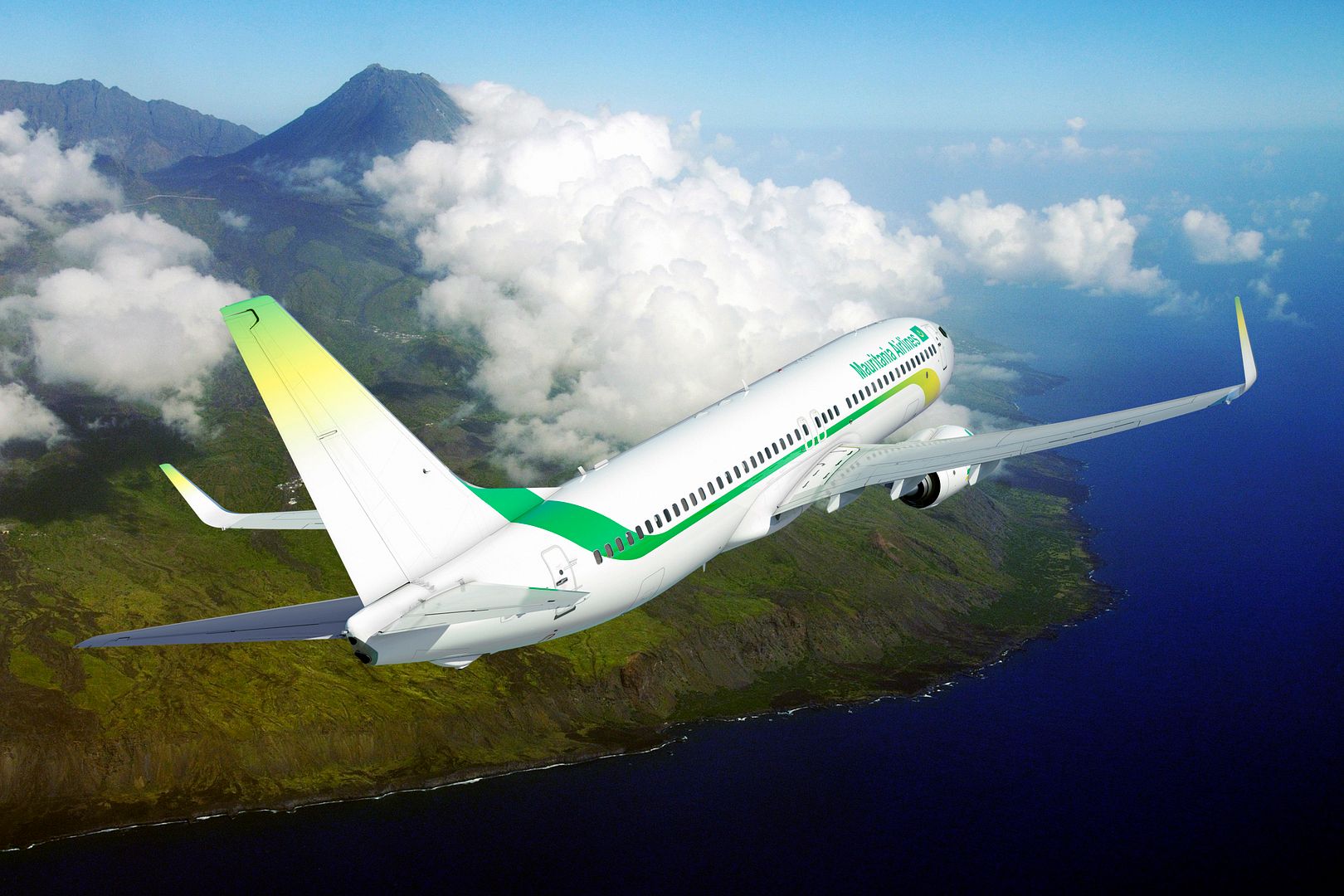
-
 Main AdminA KC-135R Stratotanker assigned to the 6th Air Refueling Wing, 91st Air Refueling Squadron, at MacDill Air Force Base, Fla., flies a training mission over central Florida. The KC-135's principal mission is air refueling while four turbofans, mounted under 35-degree swept wings, power the KC-135 to takeoffs at gross weights up to 322,500 pounds. (U.S. Air Force photo by Master Sgt Keith Reed)
Main AdminA KC-135R Stratotanker assigned to the 6th Air Refueling Wing, 91st Air Refueling Squadron, at MacDill Air Force Base, Fla., flies a training mission over central Florida. The KC-135's principal mission is air refueling while four turbofans, mounted under 35-degree swept wings, power the KC-135 to takeoffs at gross weights up to 322,500 pounds. (U.S. Air Force photo by Master Sgt Keith Reed)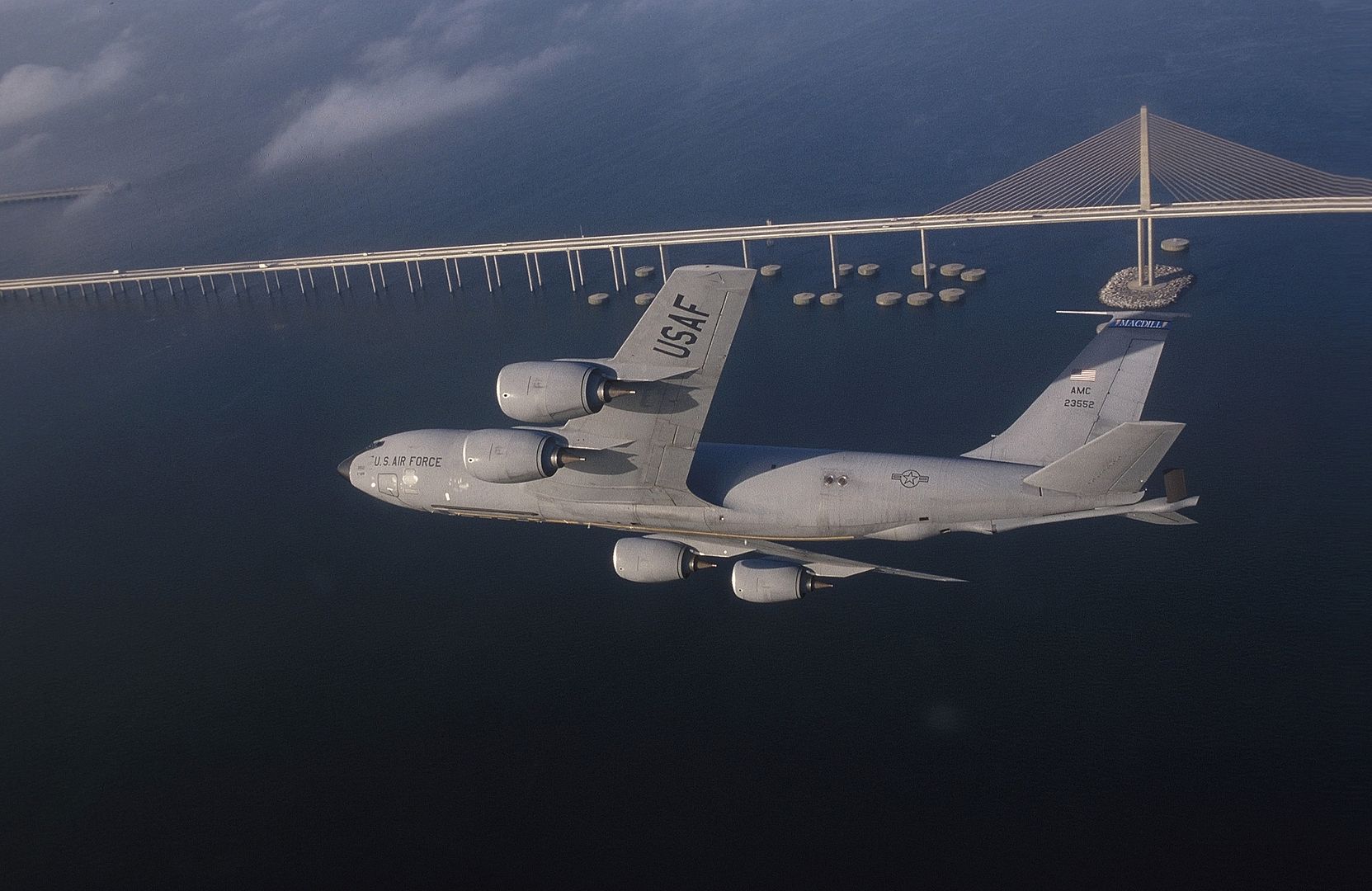
MEDITERRANEAN SEA (Aug. 8, 2016) An AV-8B Harrier with the 22nd Marine Expeditionary Unit (MEU) takes off from the flight deck aboard the amphibious assault ship USS Wasp (LHD 1). The 22nd MEU, embarked on Wasp, is conducting precision air strikes in support of the Libyan Government of National Accord-aligned forces against ISIL targets in Sirte, Libya as part of Operation Odyssey Lightning. (U.S. Navy photo by Mass Communication Specialist 3rd Class Zhiwei Tan/Released)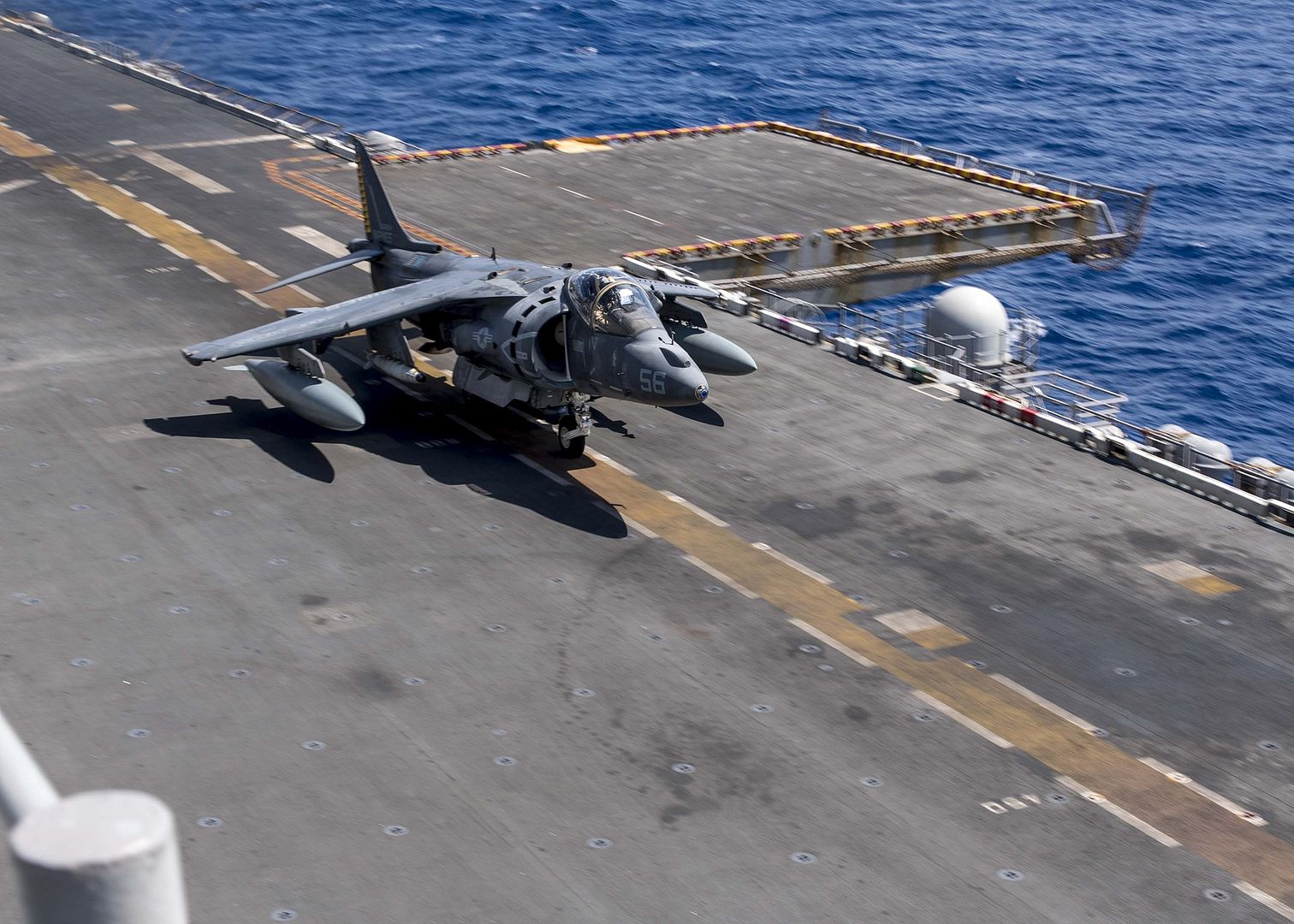
ARABIAN GULF (Aug. 8, 2016) An E-2C Hawkeye assigned to the Screwtops Airborne Early Warning Squadron (VAW) 123 taxis across the flight deck of the aircraft carrier USS Dwight D. Eisenhower (CVN 69) (Ike). Ike and its Carrier Strike Group are deployed in support of Operation Inherent Resolve, maritime security operations and theater security cooperation efforts in the U.S. 5th Fleet area of operations. (U.S. Navy photo by Mass Communication Specialist 3rd Class J. Alexander Delgado/Released)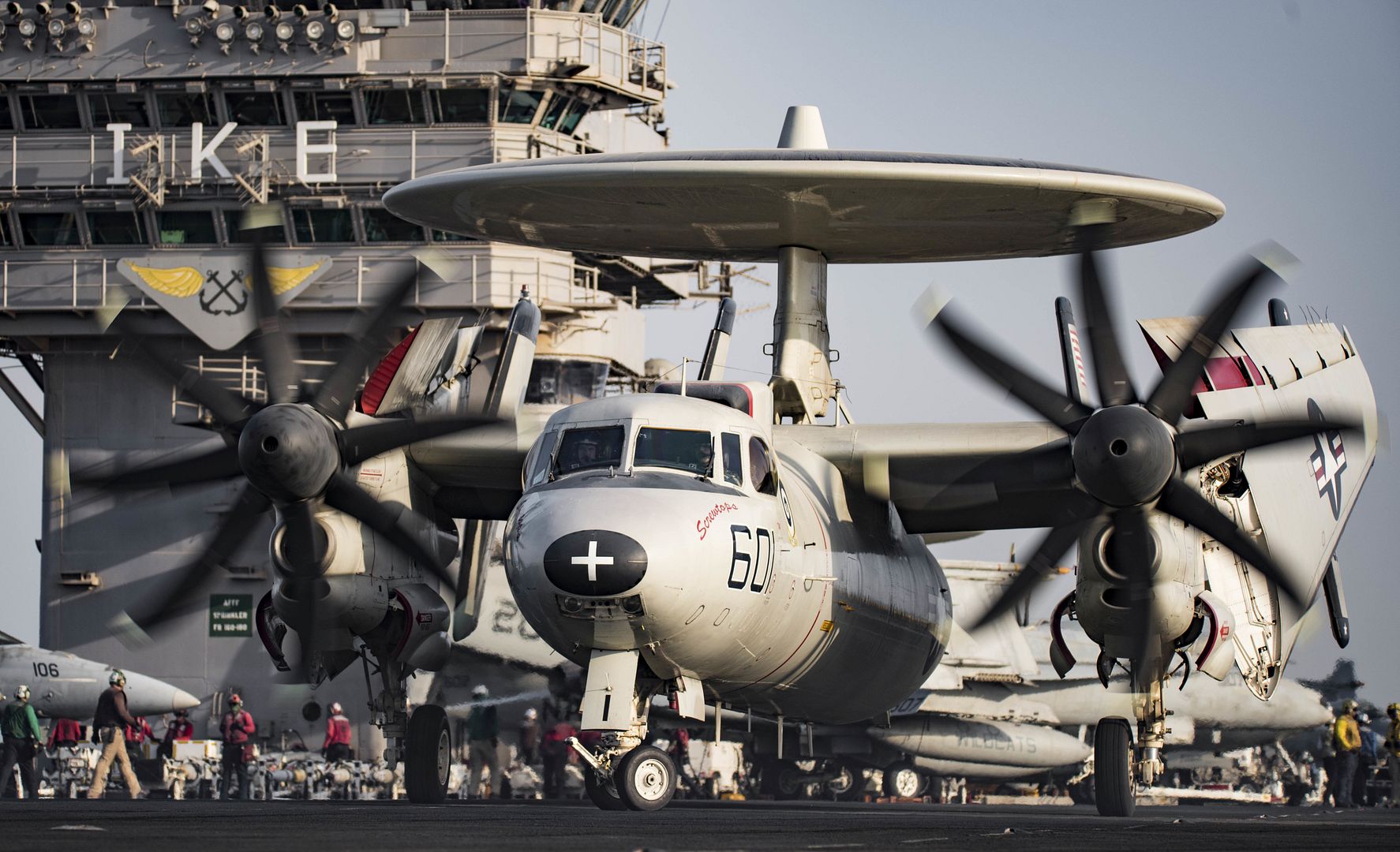
ARABIAN GULF (Aug. 8, 2016) An F/A-18C Hornet assigned to the Wildcats of Strike Fighter Squadron (VFA) 131 lands on the flight deck of the aircraft carrier USS Dwight D. Eisenhower (CVN 69) (Ike). Ike and its Carrier Strike Group are deployed in support of Operation Inherent Resolve, maritime security operations and theater security cooperation efforts in the U.S. 5th Fleet area of operations. (U.S. Navy photo by Mass Communication Specialist 3rd Class J. Alexander Delgado/Released)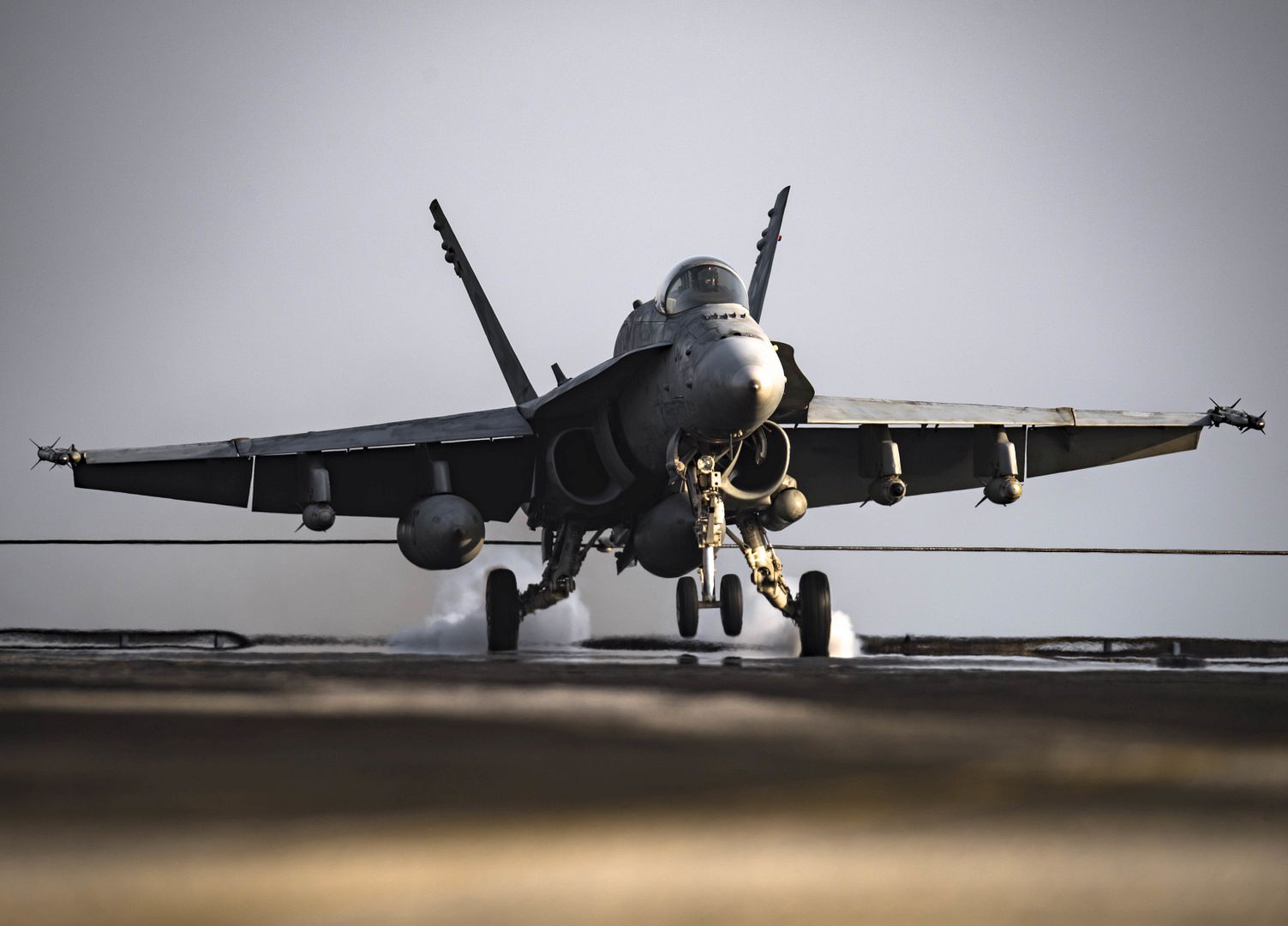
An F/A-18C Hornet with Marine Fighter Attack Squadron (VMFA) 122 moves in to catch the basket during an aerial refueling mission with Marine Aerial Refueler Transport Squadron (VMGR) 152 at Royal Australian Air Force Base Tindal, Australia during Exercise Pitch Black 2016, Aug. 9, 2016. VMGR-152 provides aerial refueling and assault support during expeditionary and joint or combined operations like Pitch Black. This exercise is a biennial, three week, multinational, large-force training exercise hosted by RAAF Tindal. (U.S. Marine Corps photo by Cpl. Nicole Zurbrugg)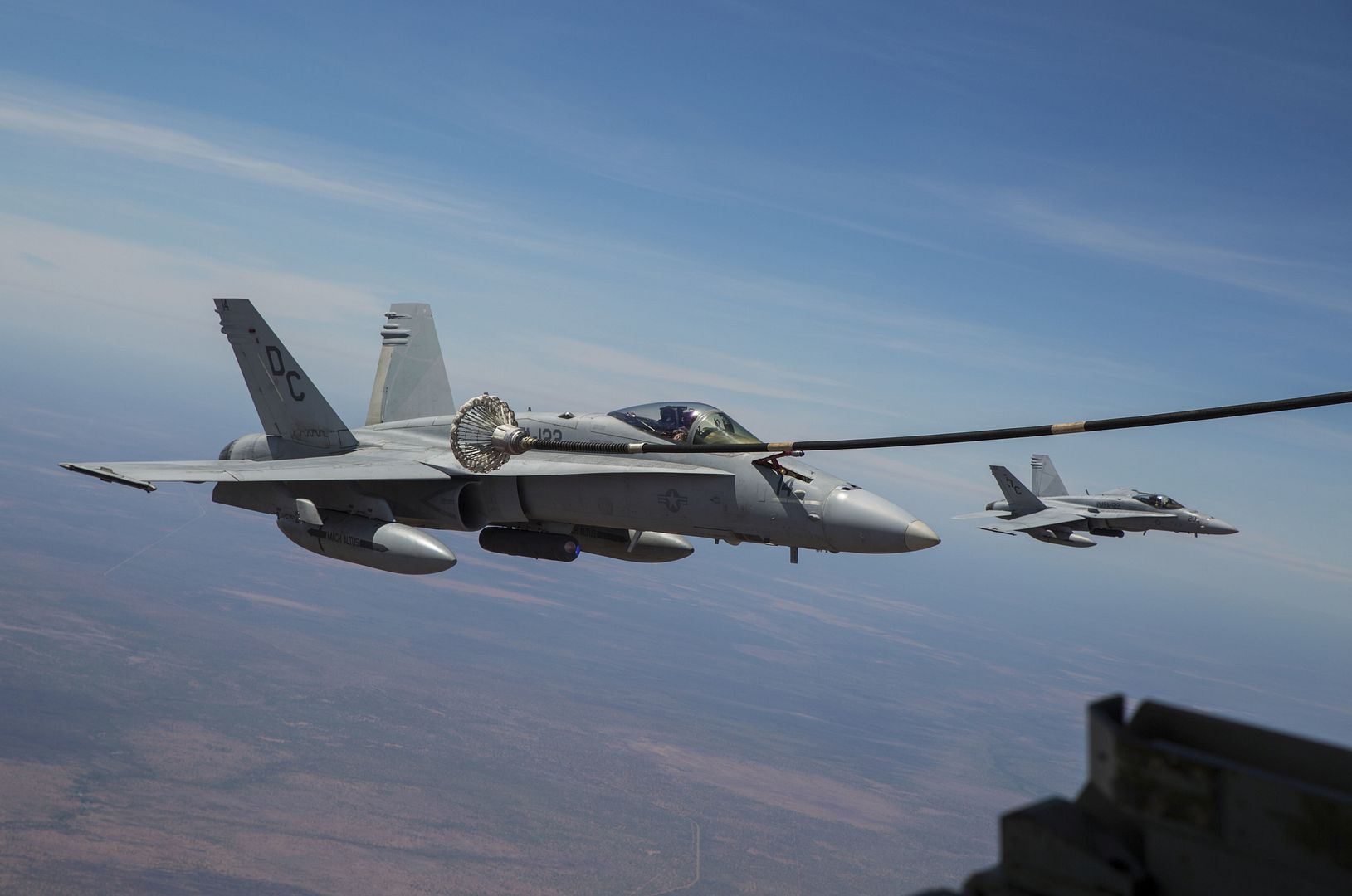
Post a reply
- Go to Next topic
- Go to Welcome
- Go to Introduce Yourself
- Go to General Discussion
- Go to Screenshots, Images and Videos
- Go to Off topic
- Go to Works in Progress
- Go to Skinning Tips / Tutorials
- Go to Skin Requests
- Go to IJAAF Library
- Go to Luftwaffe Library
- Go to RAF Library
- Go to USAAF / USN Library
- Go to Misc Library
- Go to The Ops Room
- Go to Made in Germany
- Go to Campaigns and Missions
- Go to Works in Progress
- Go to Juri's Air-Raid Shelter
- Go to Campaigns and Missions
- Go to Works in Progress
- Go to Skinpacks
- Go to External Projects Discussion
- Go to Books & Resources
